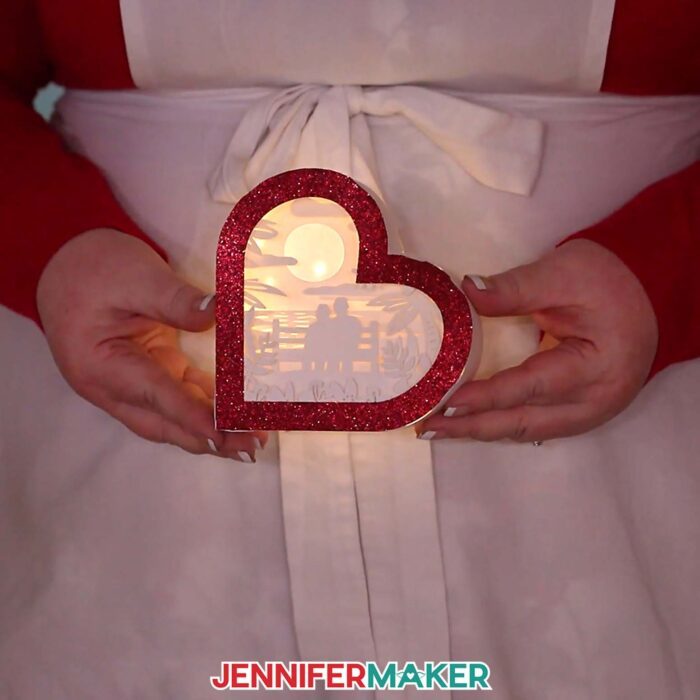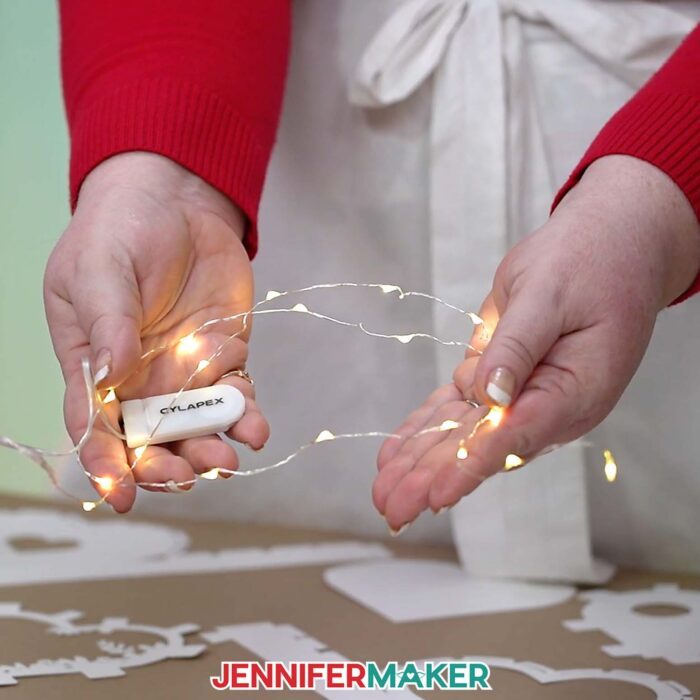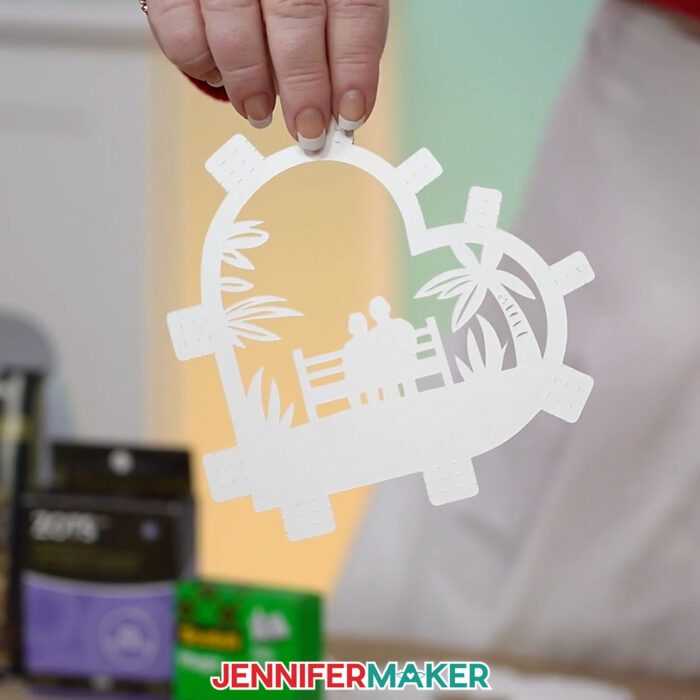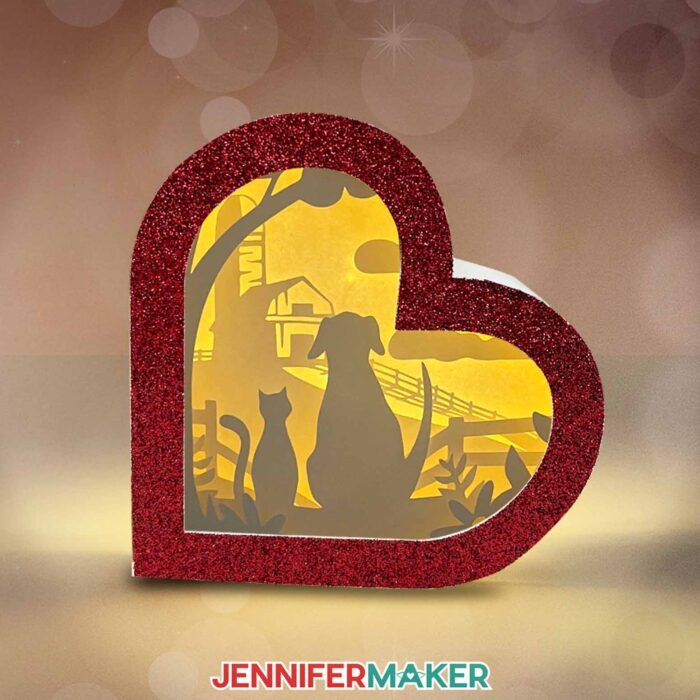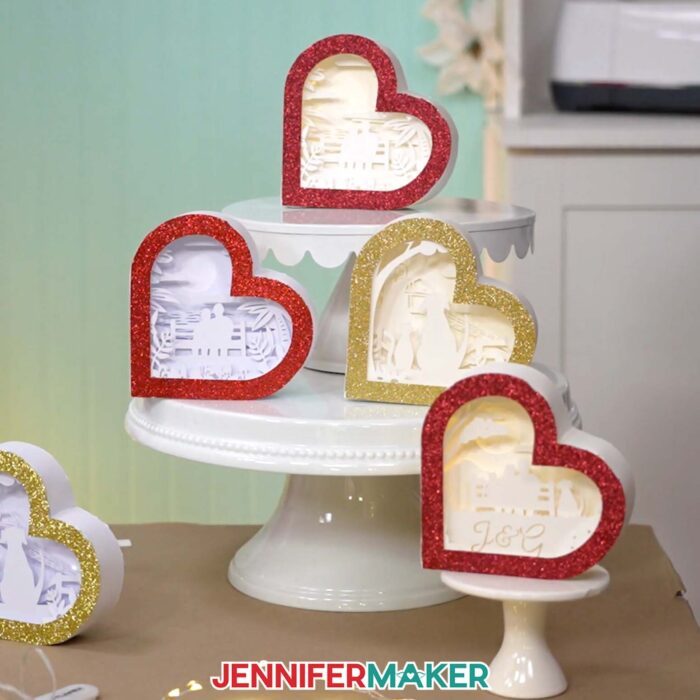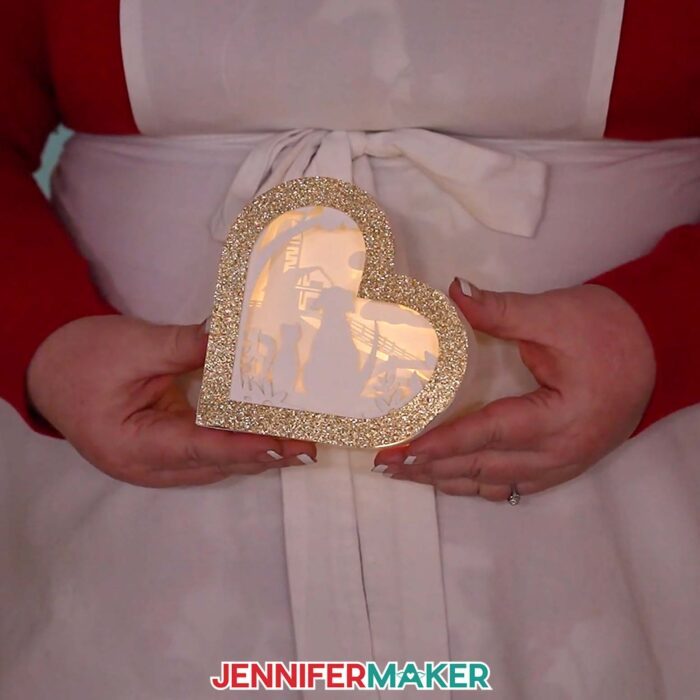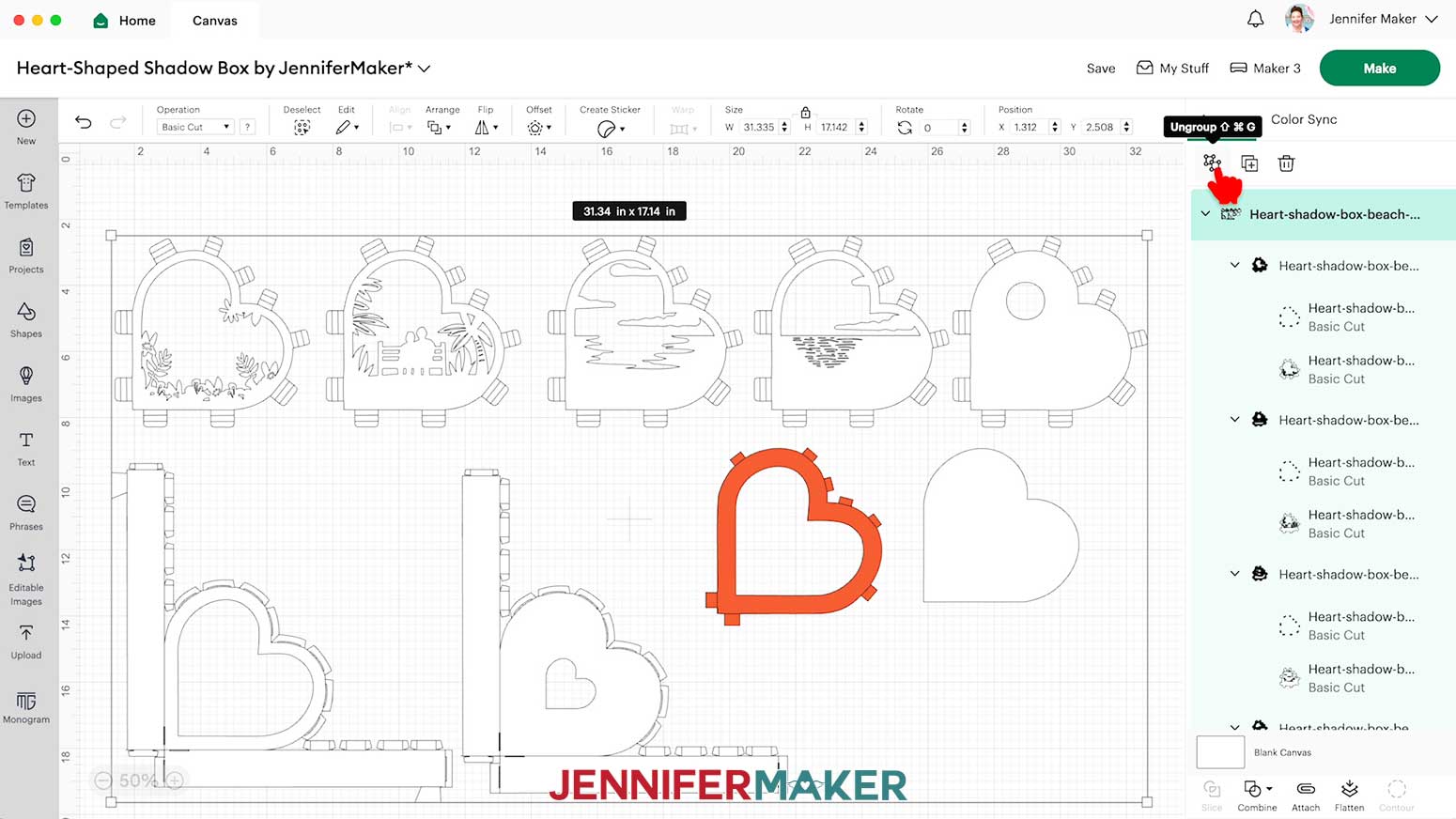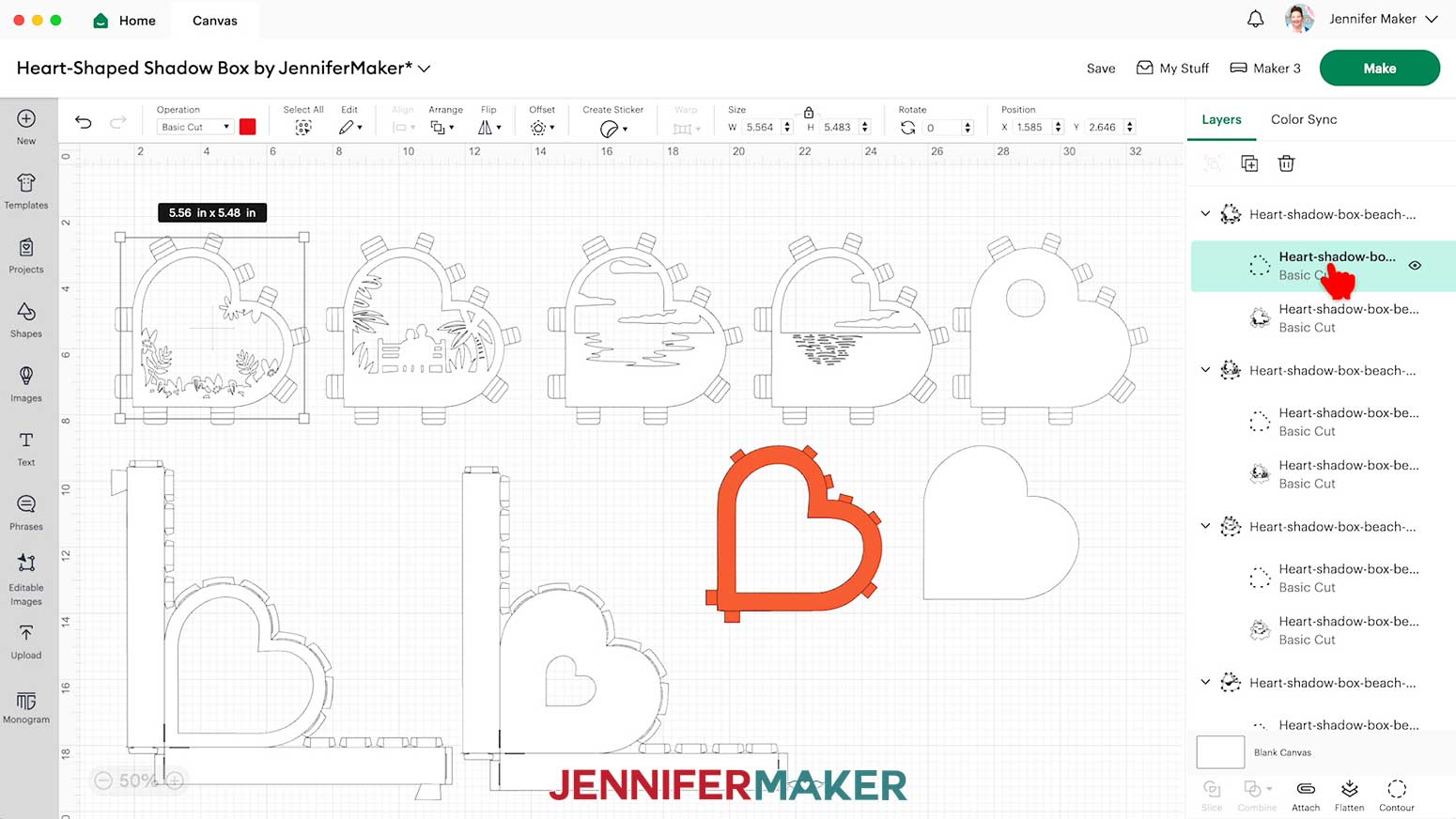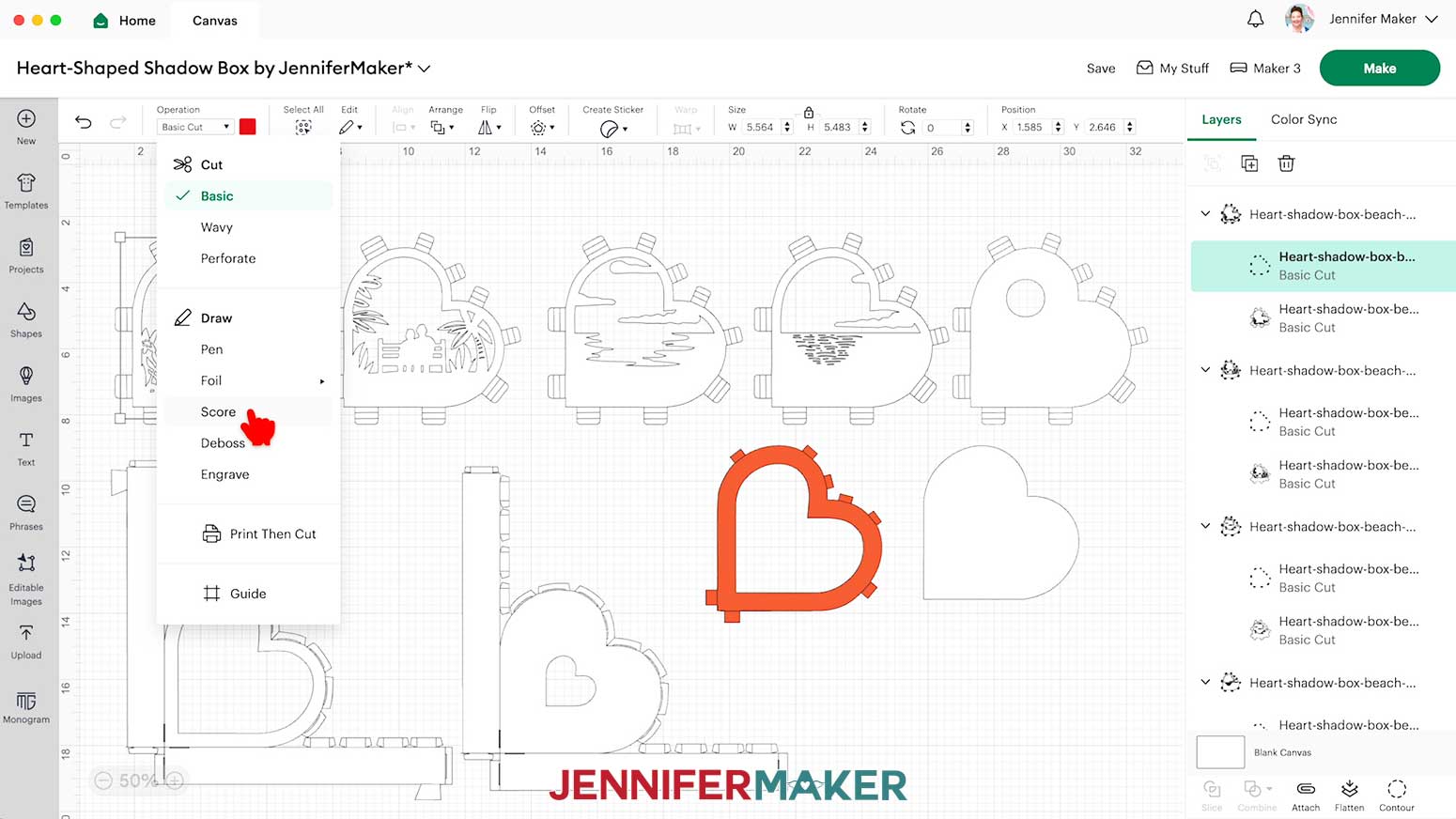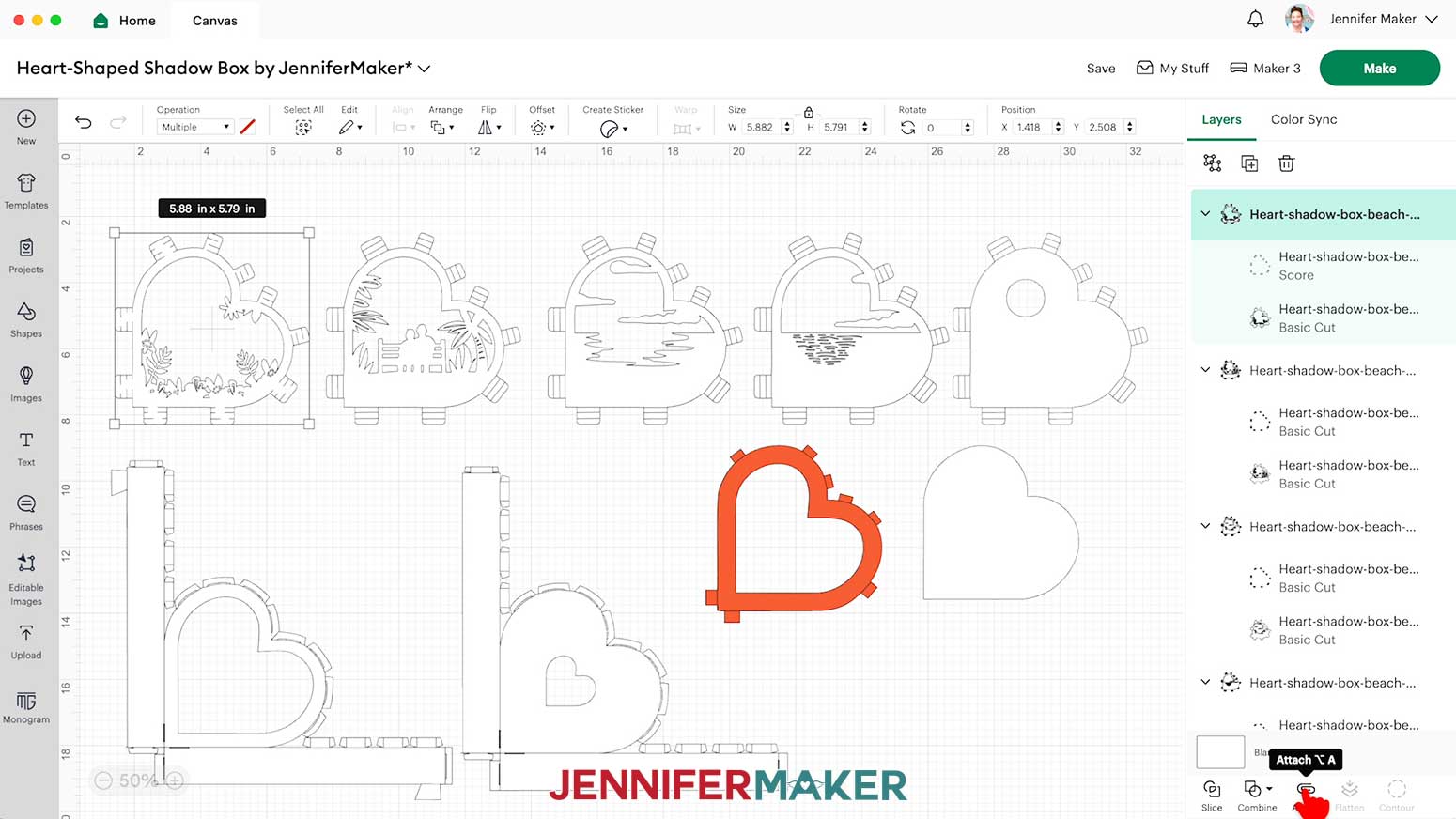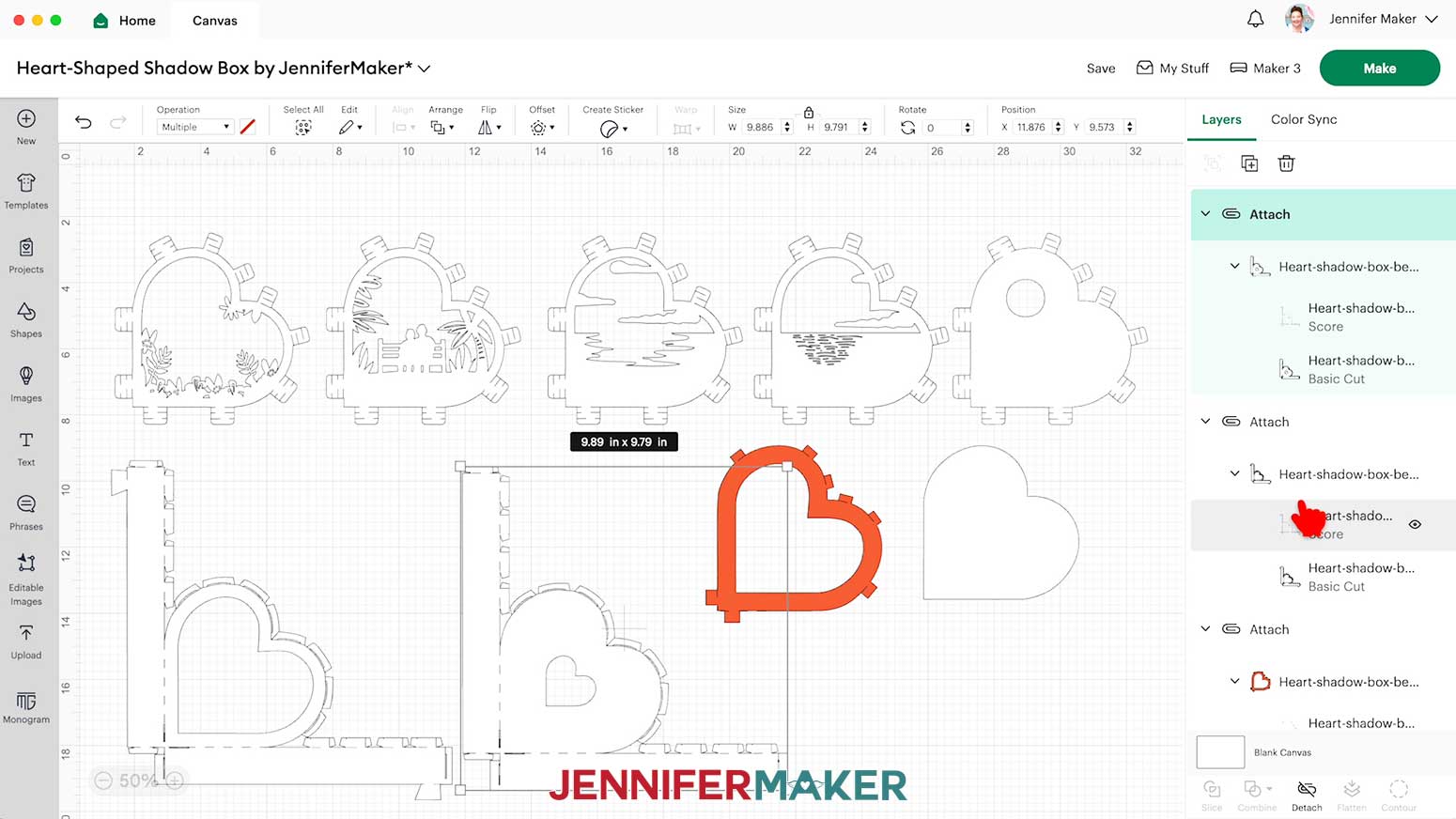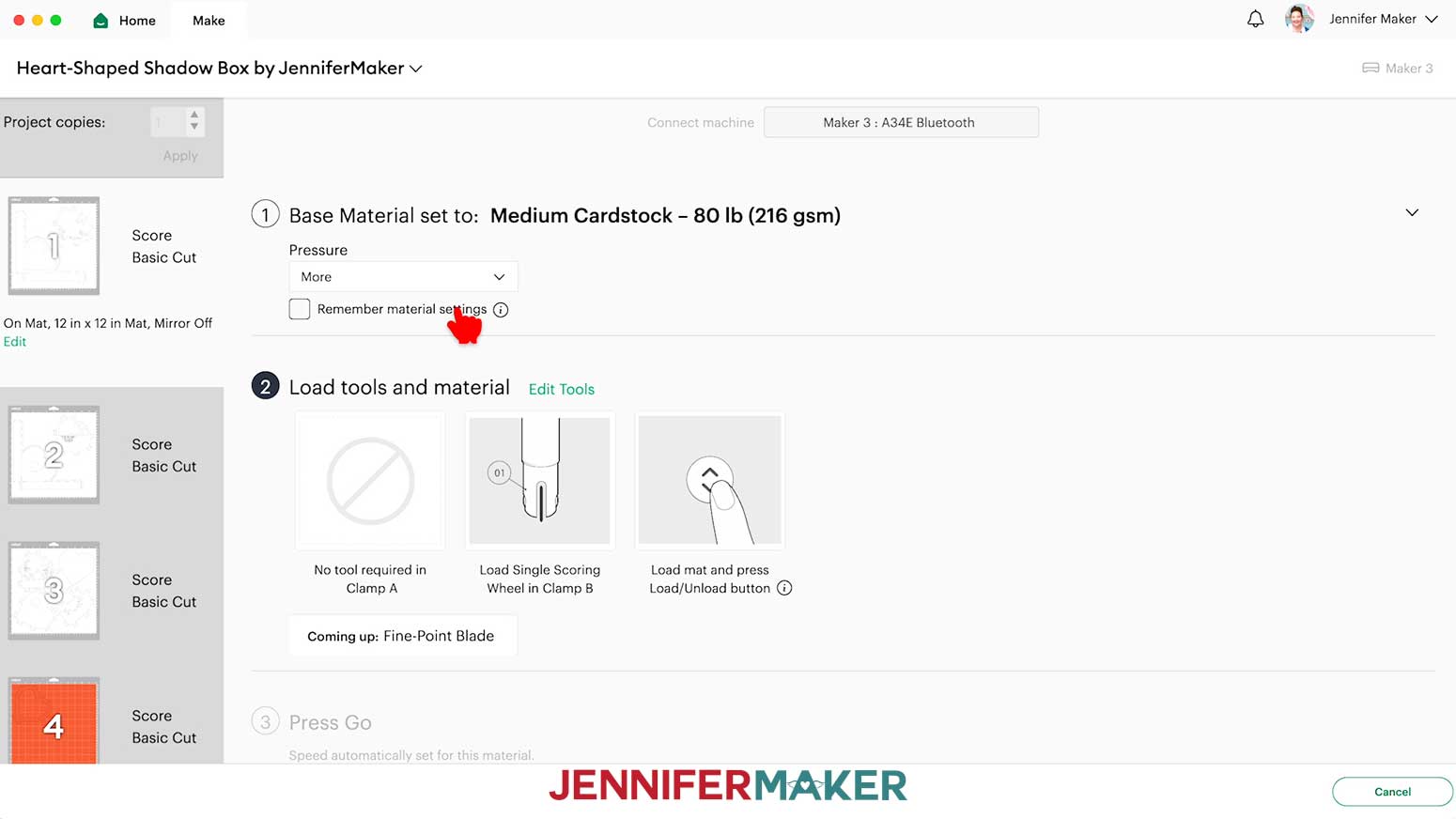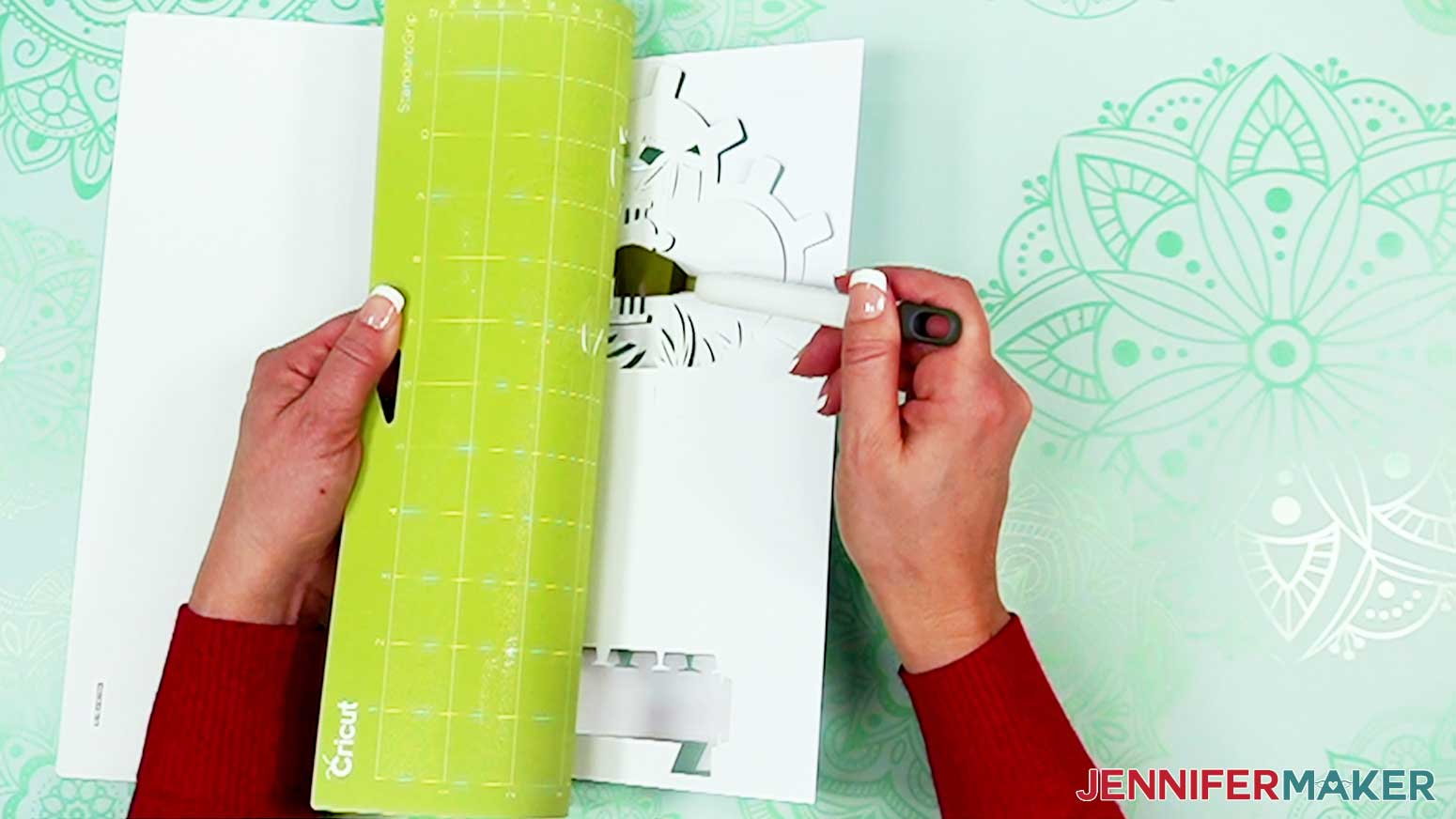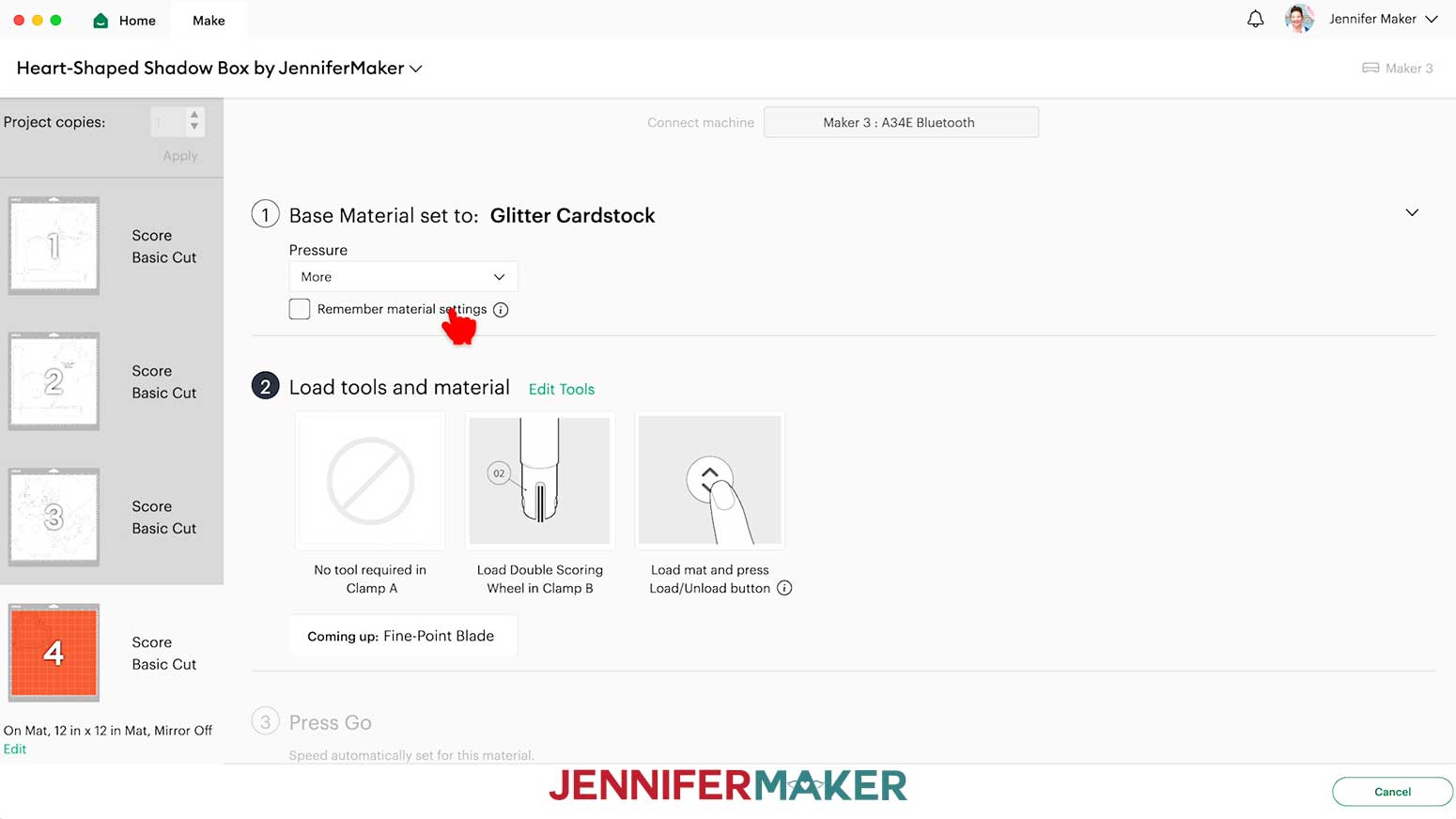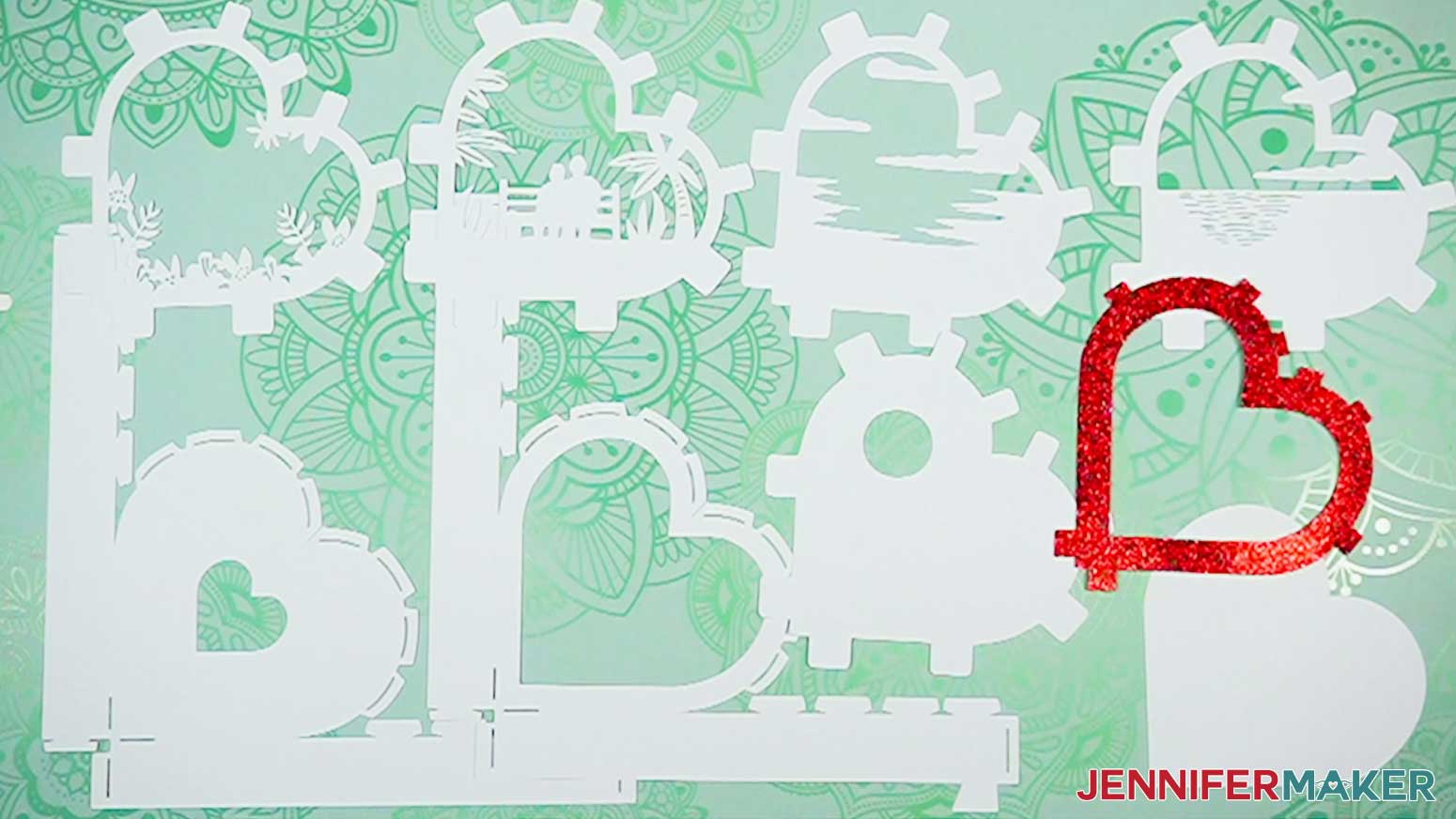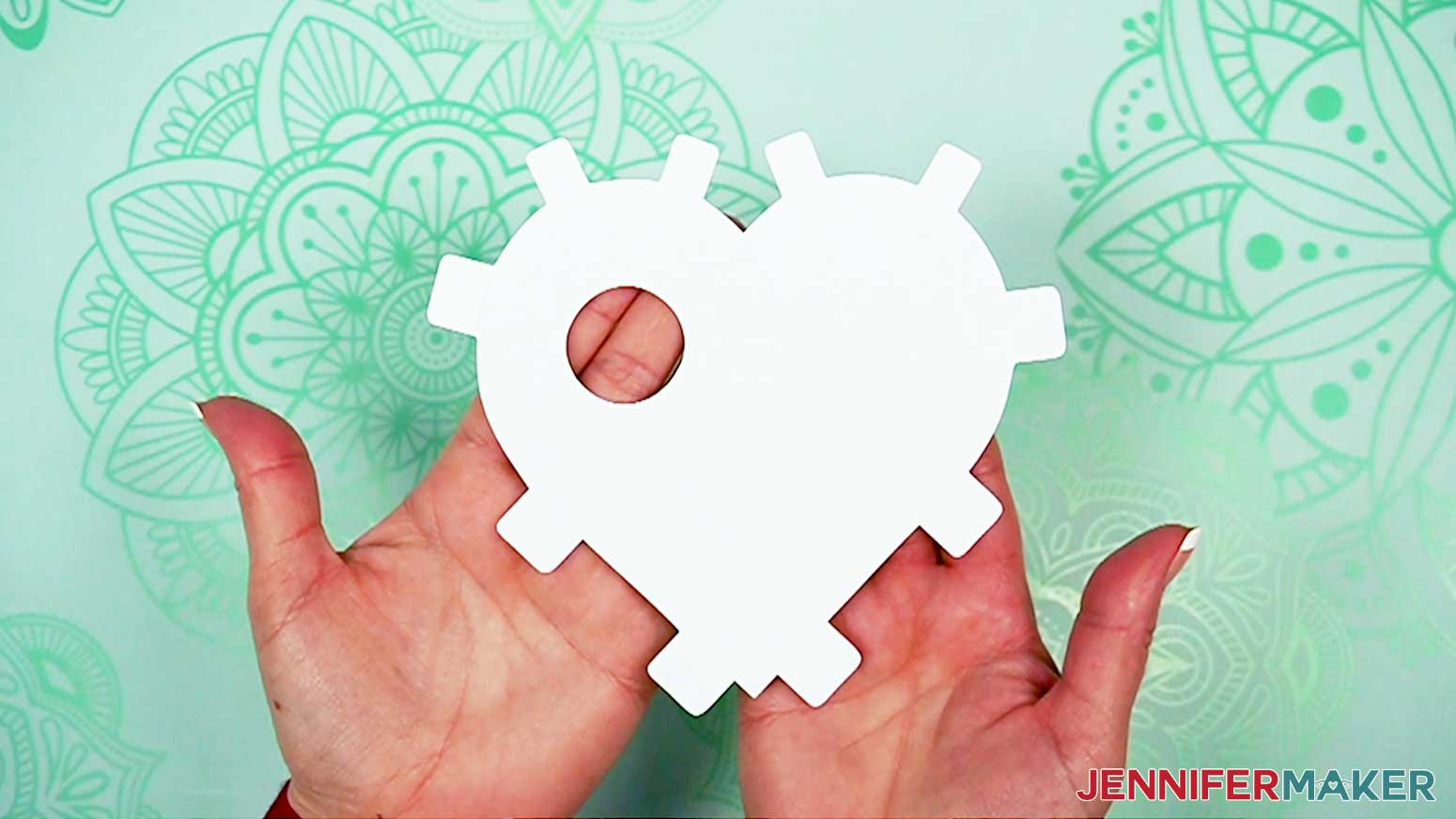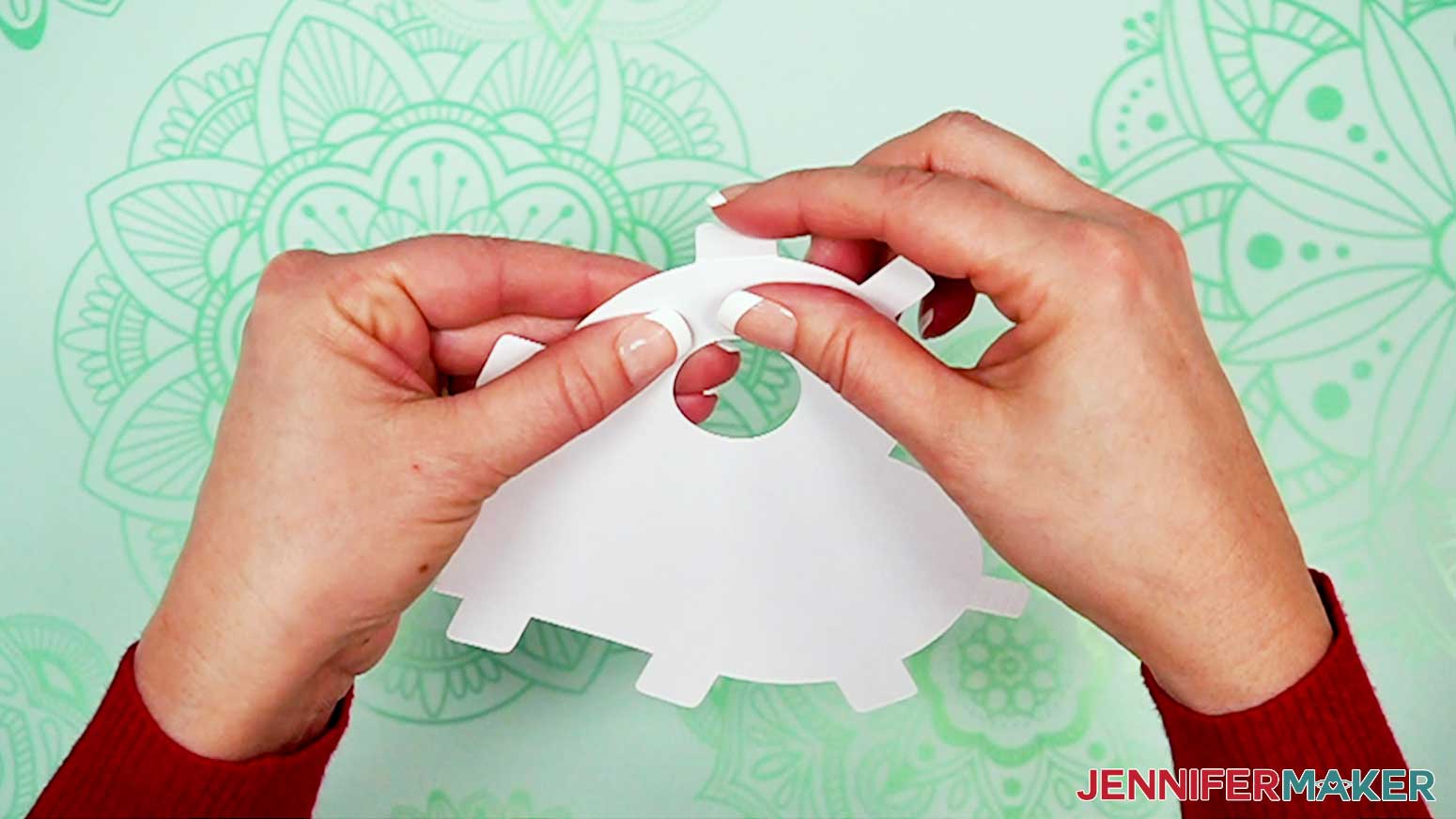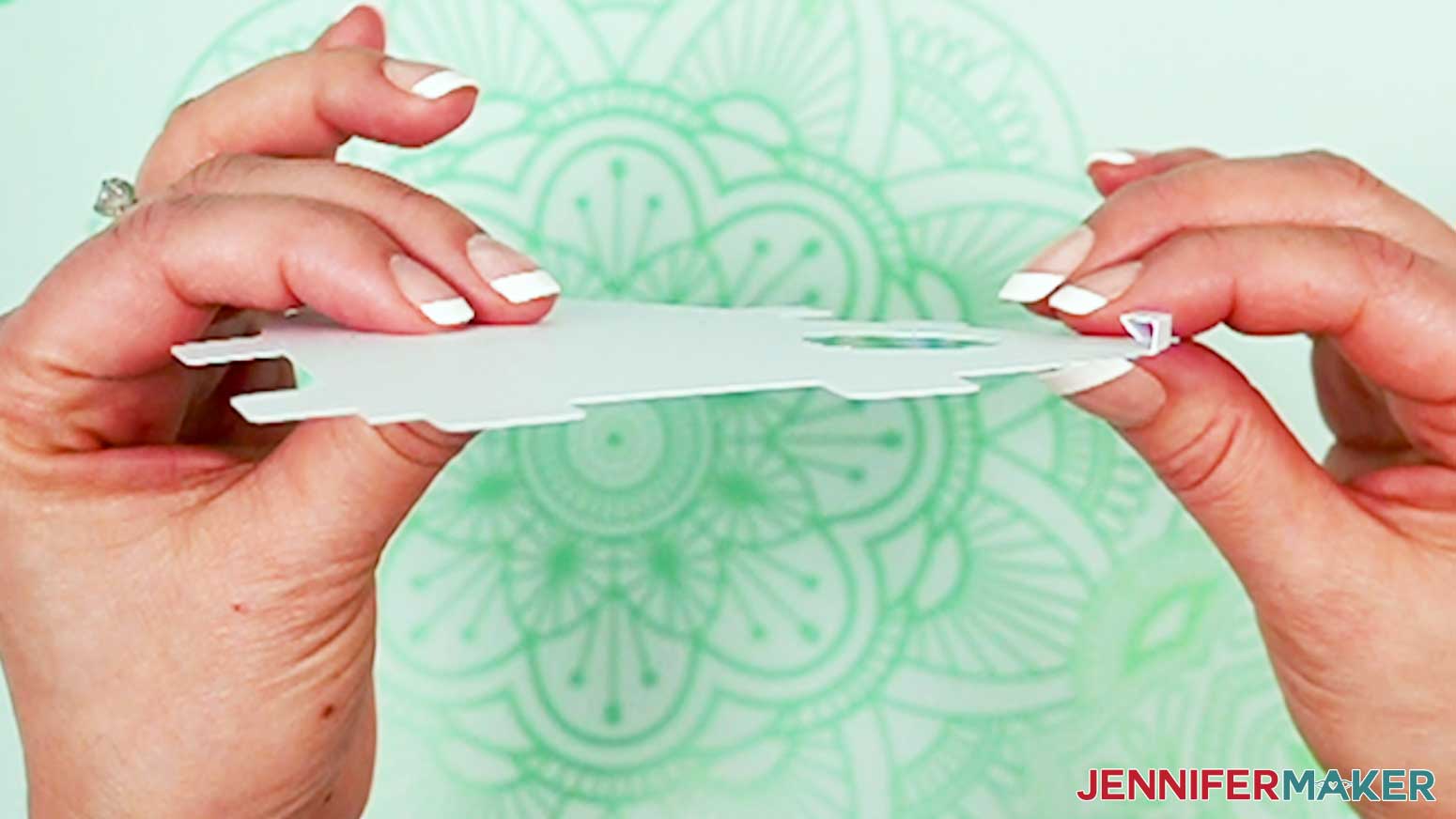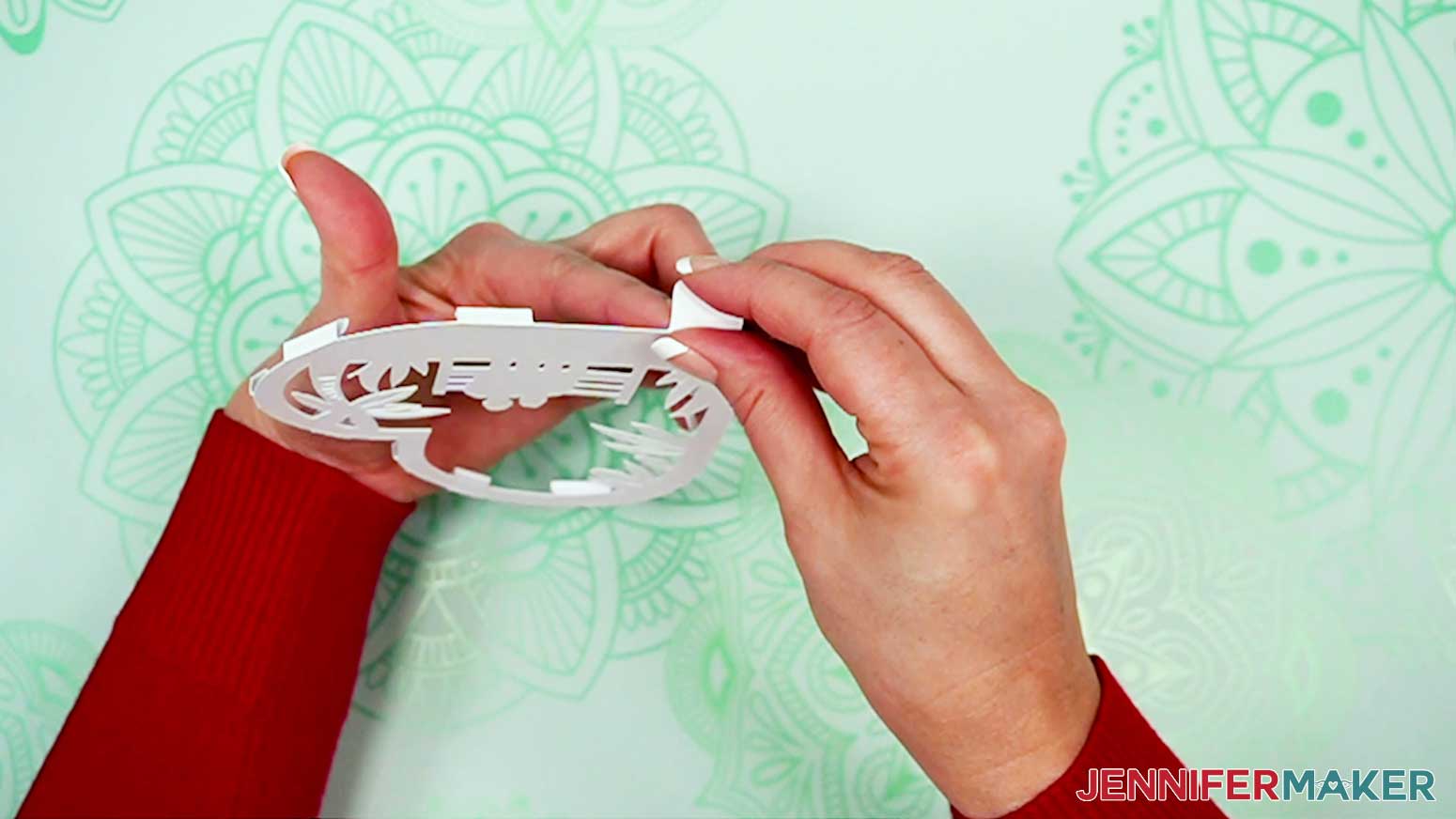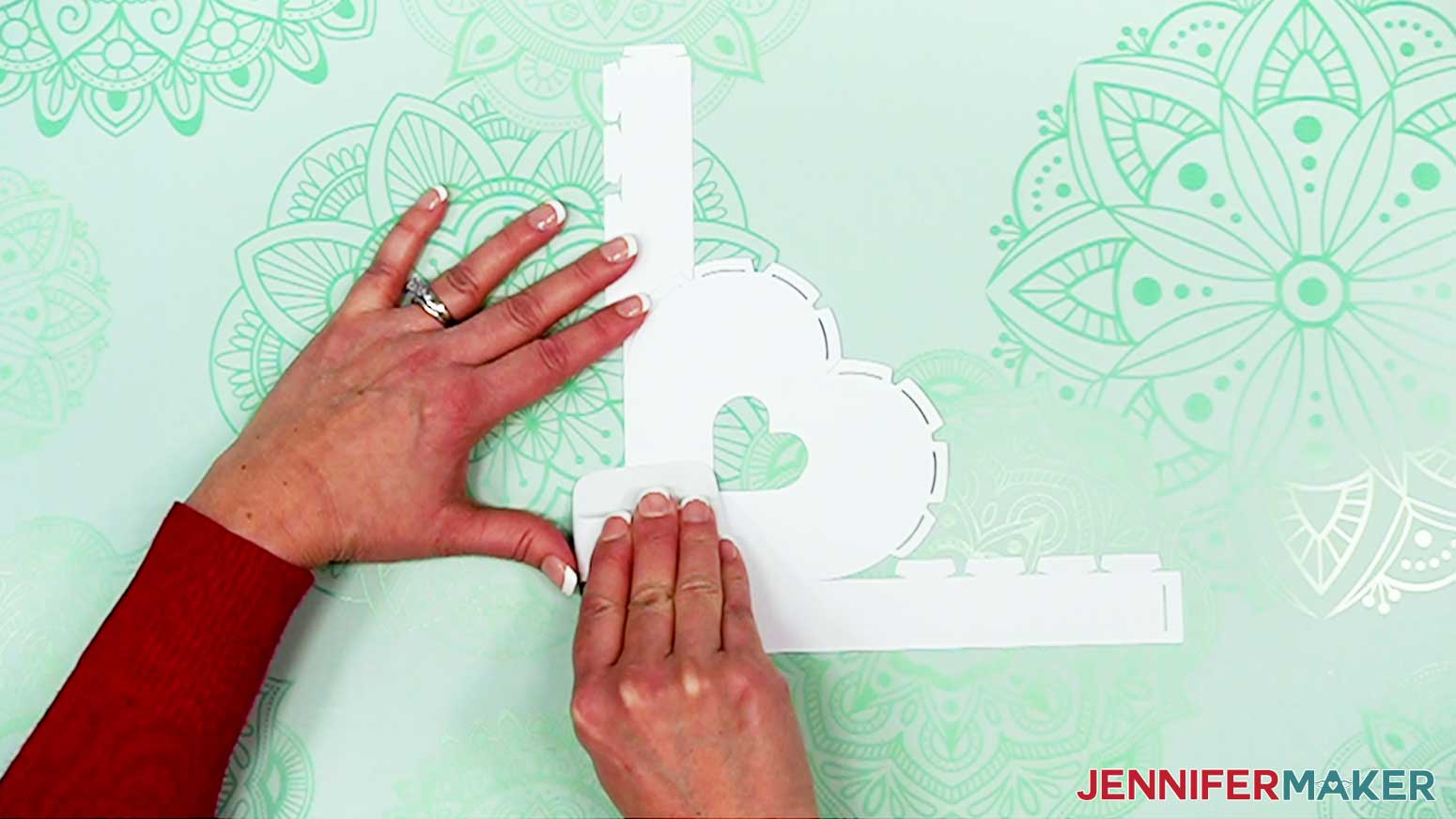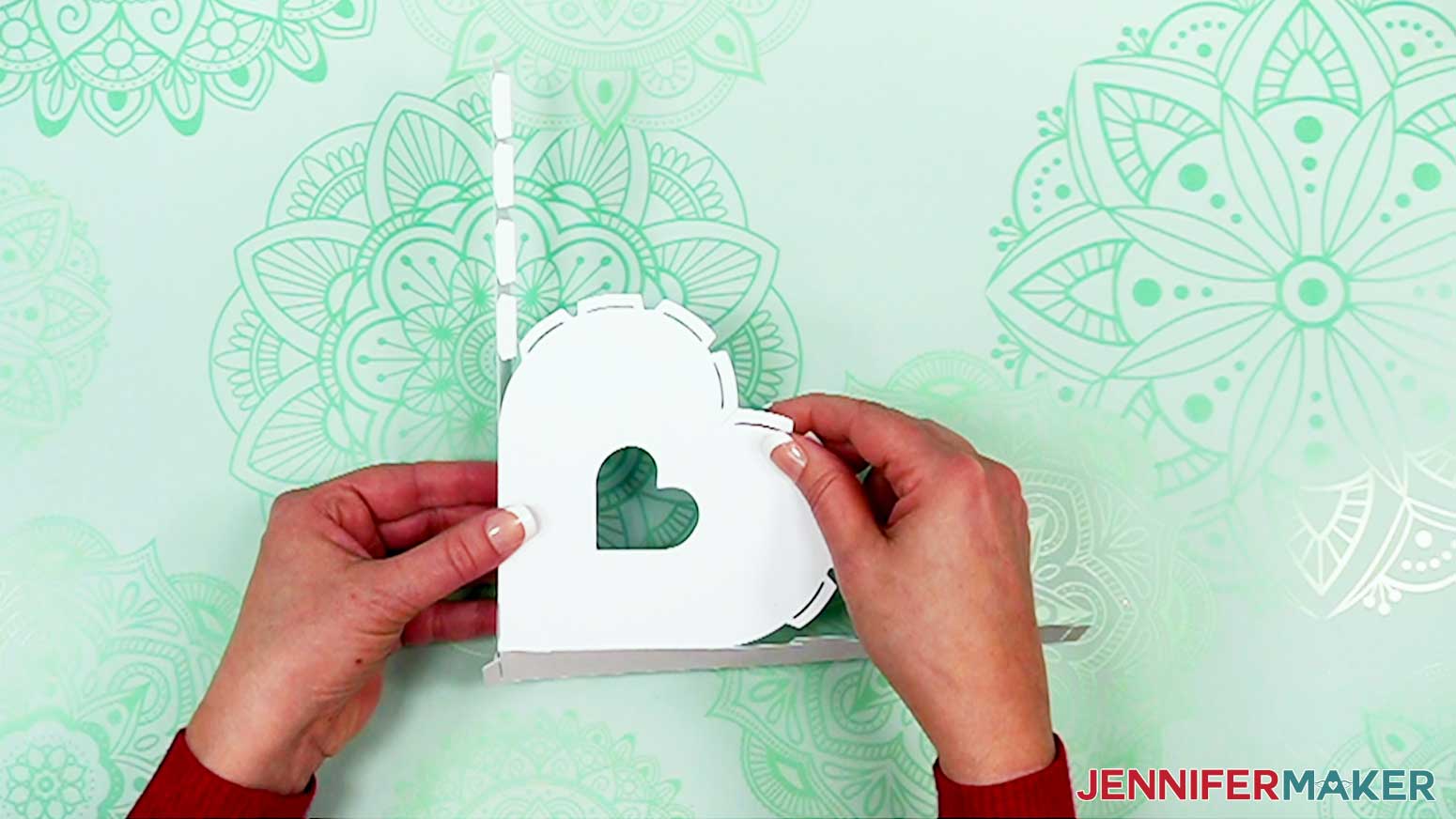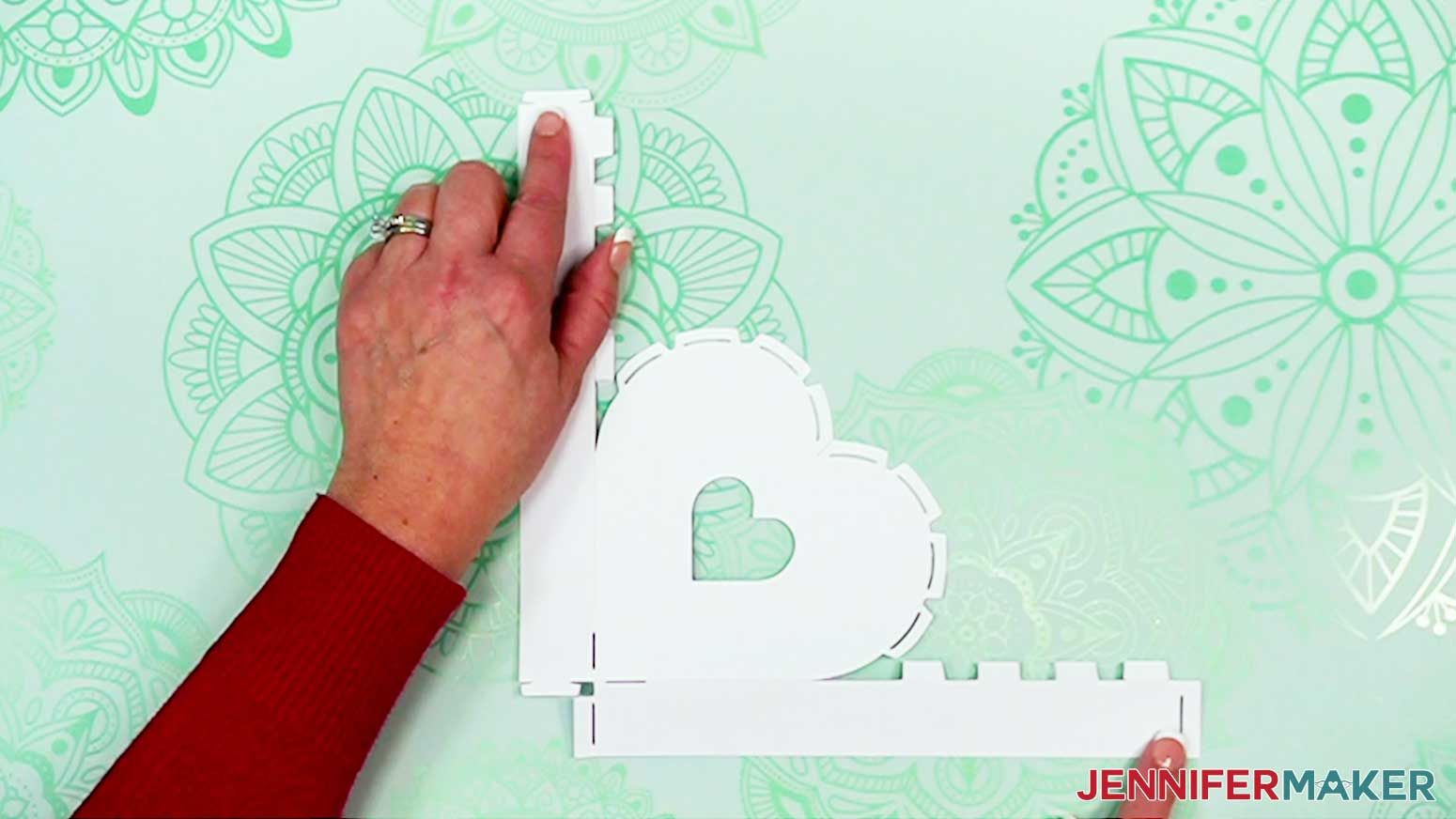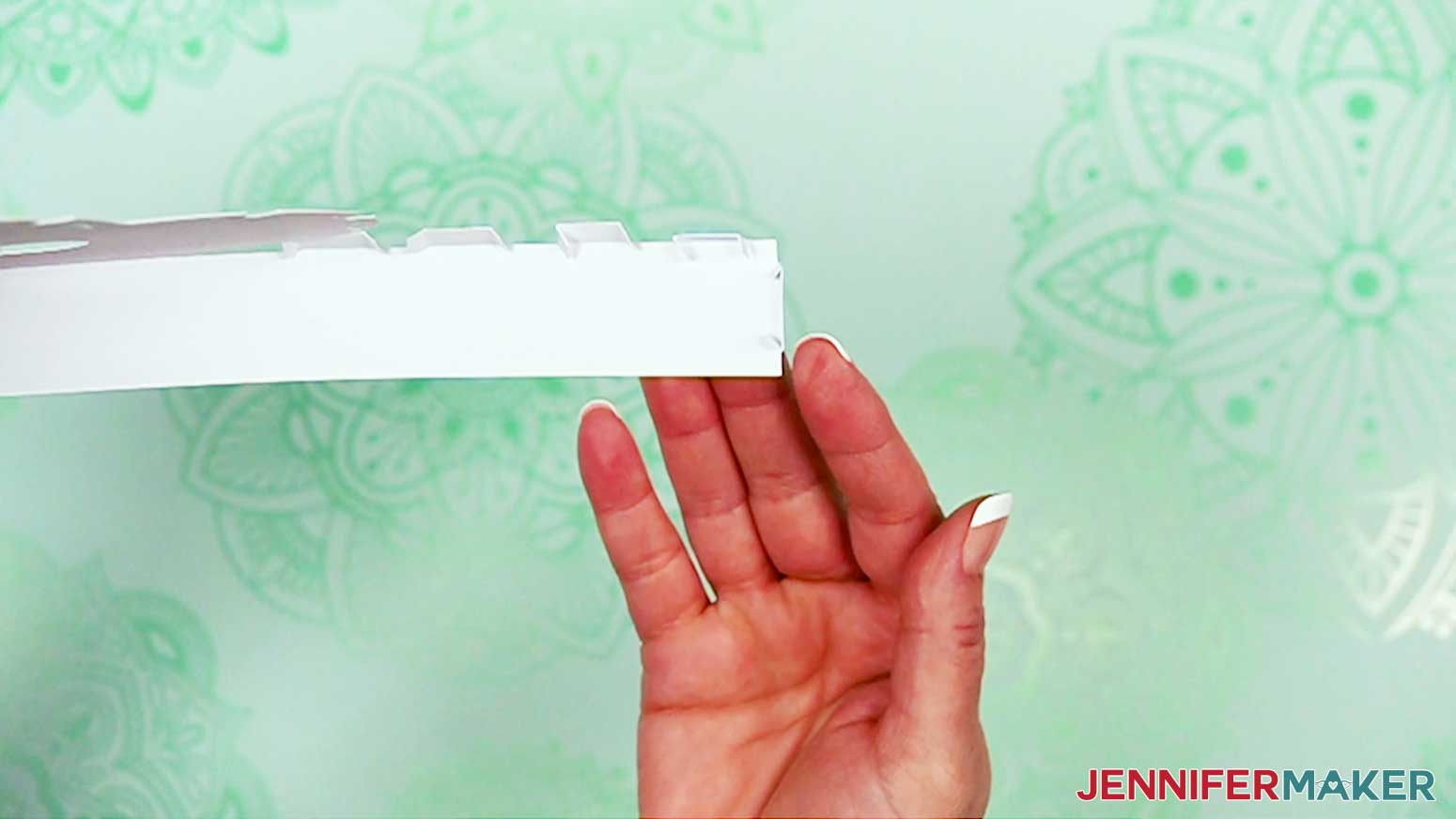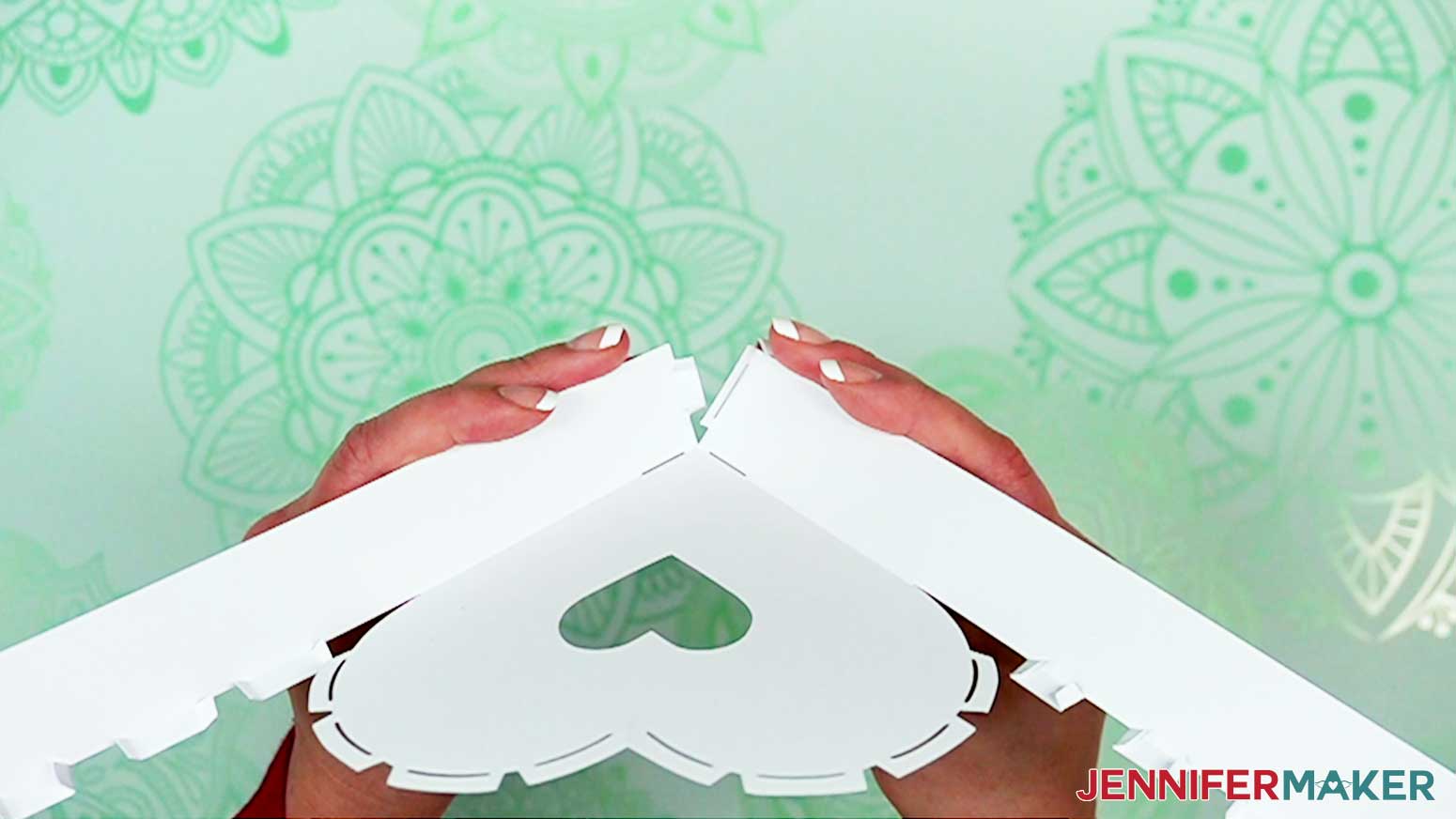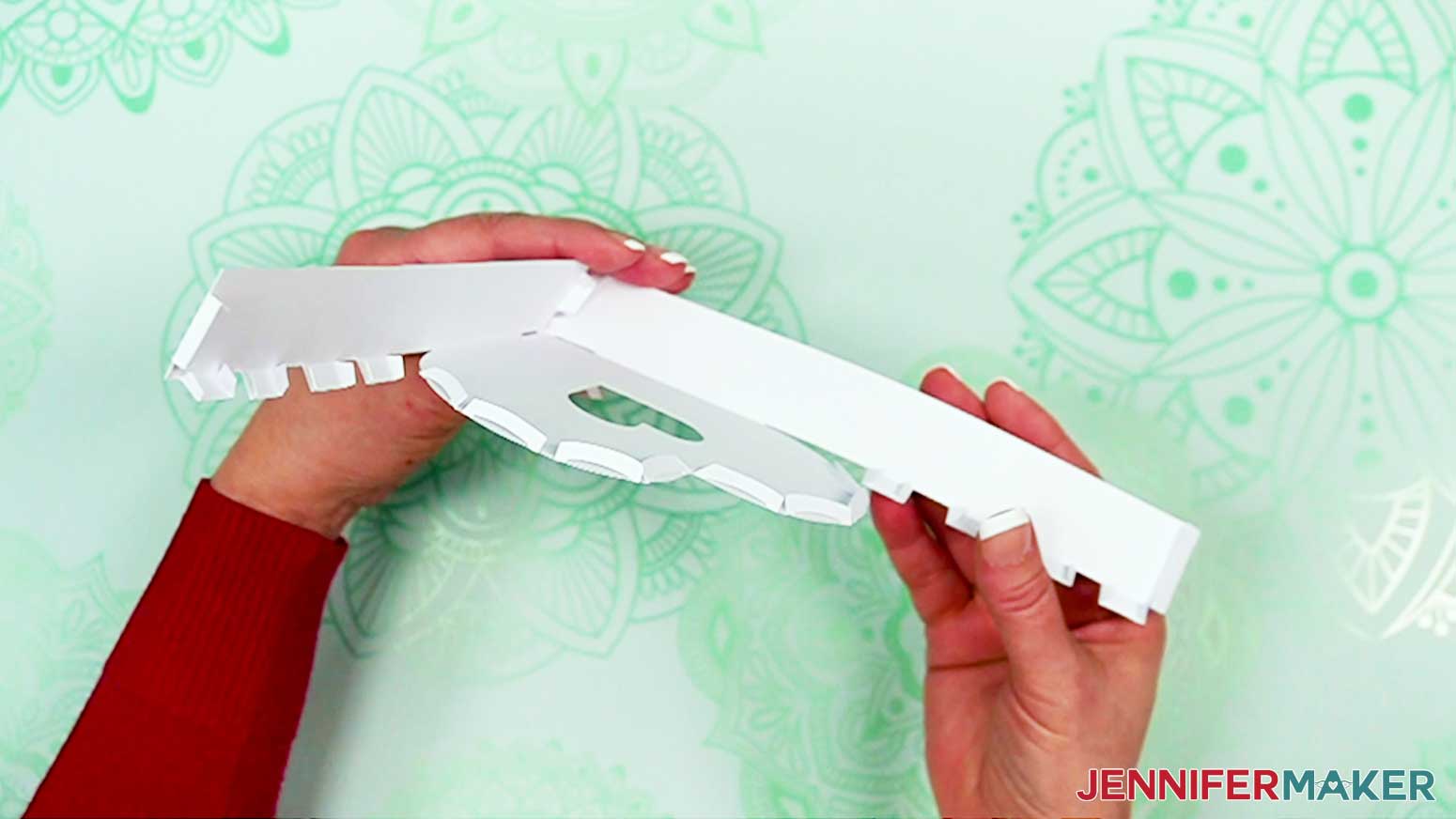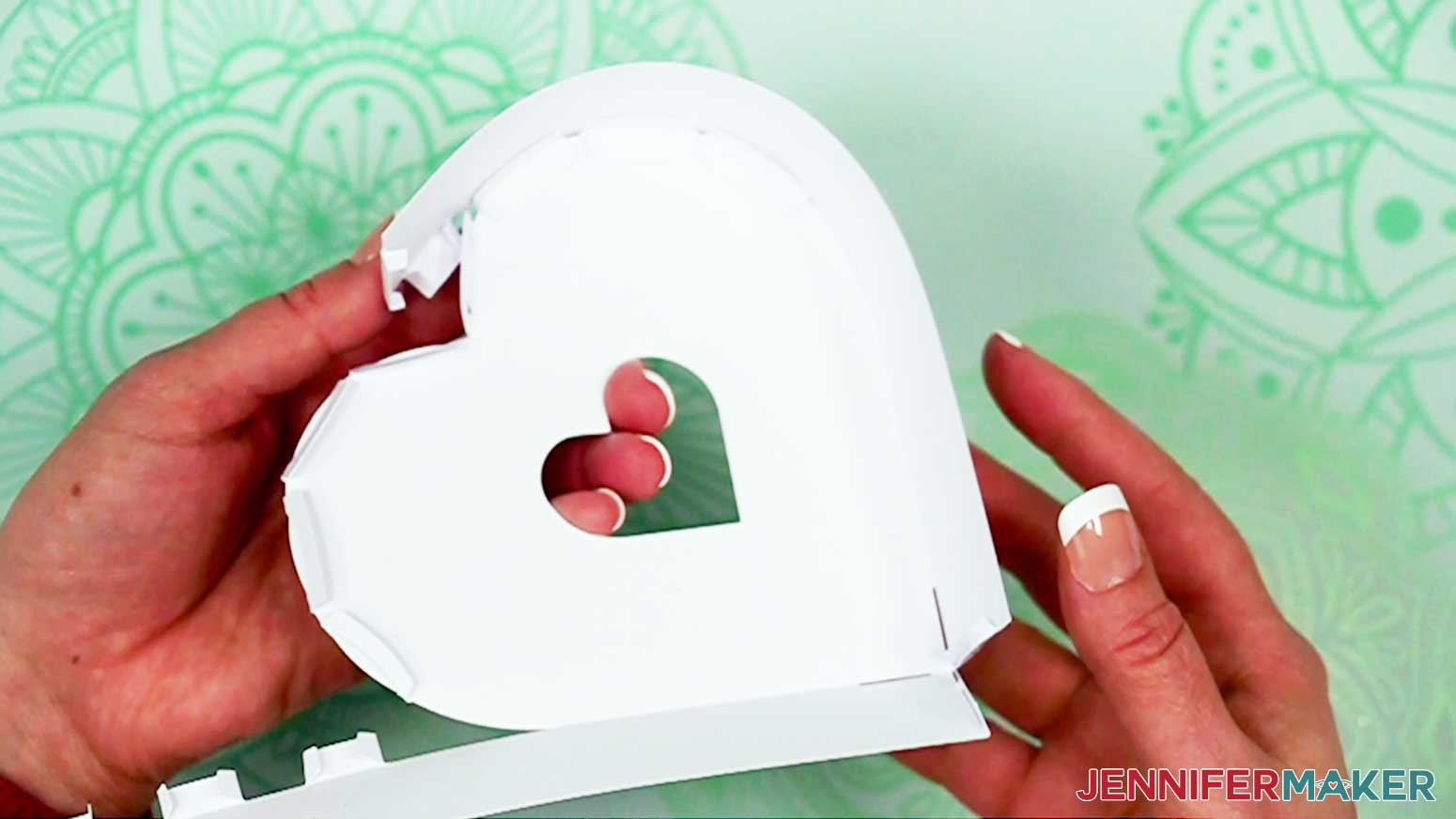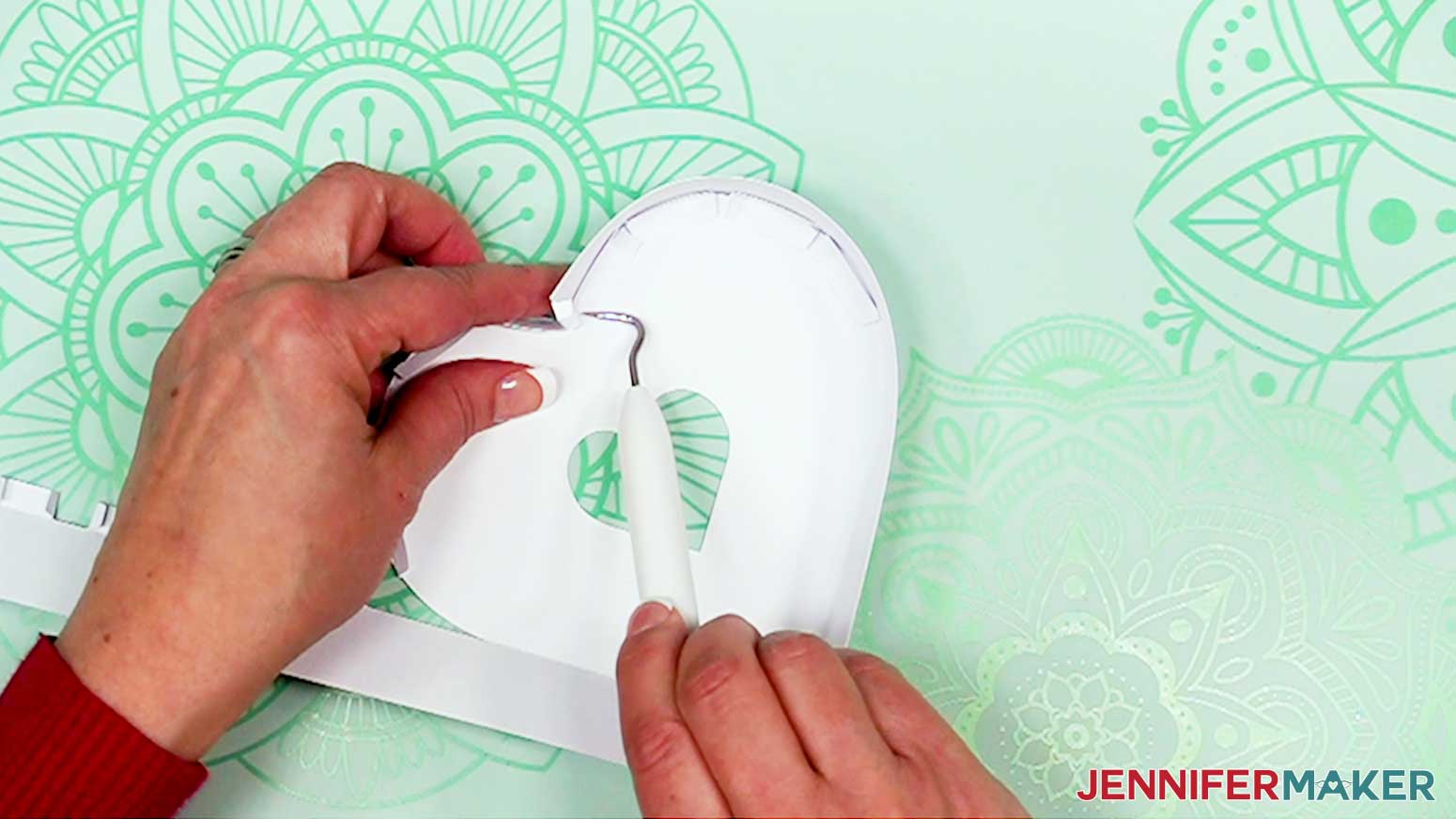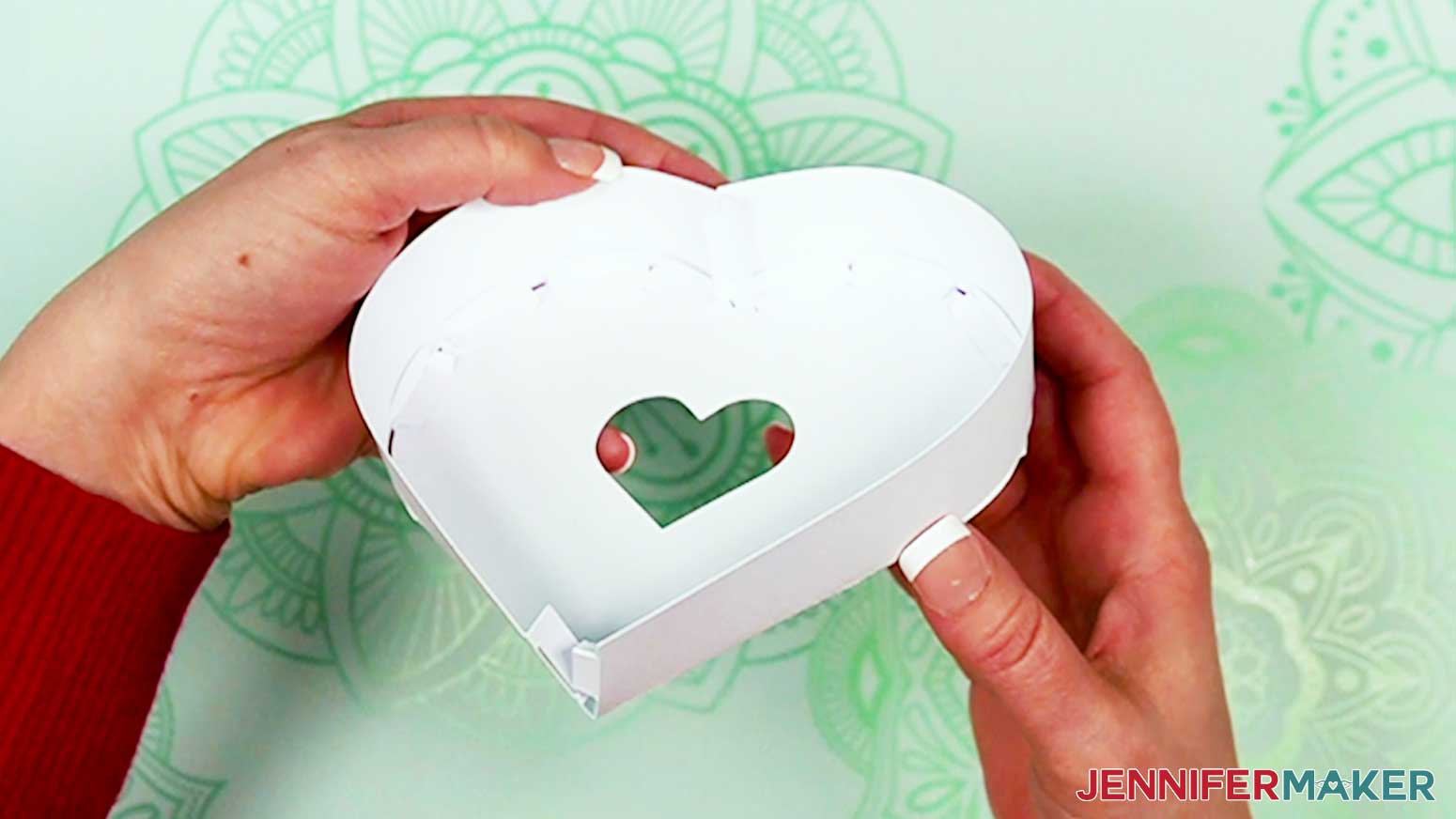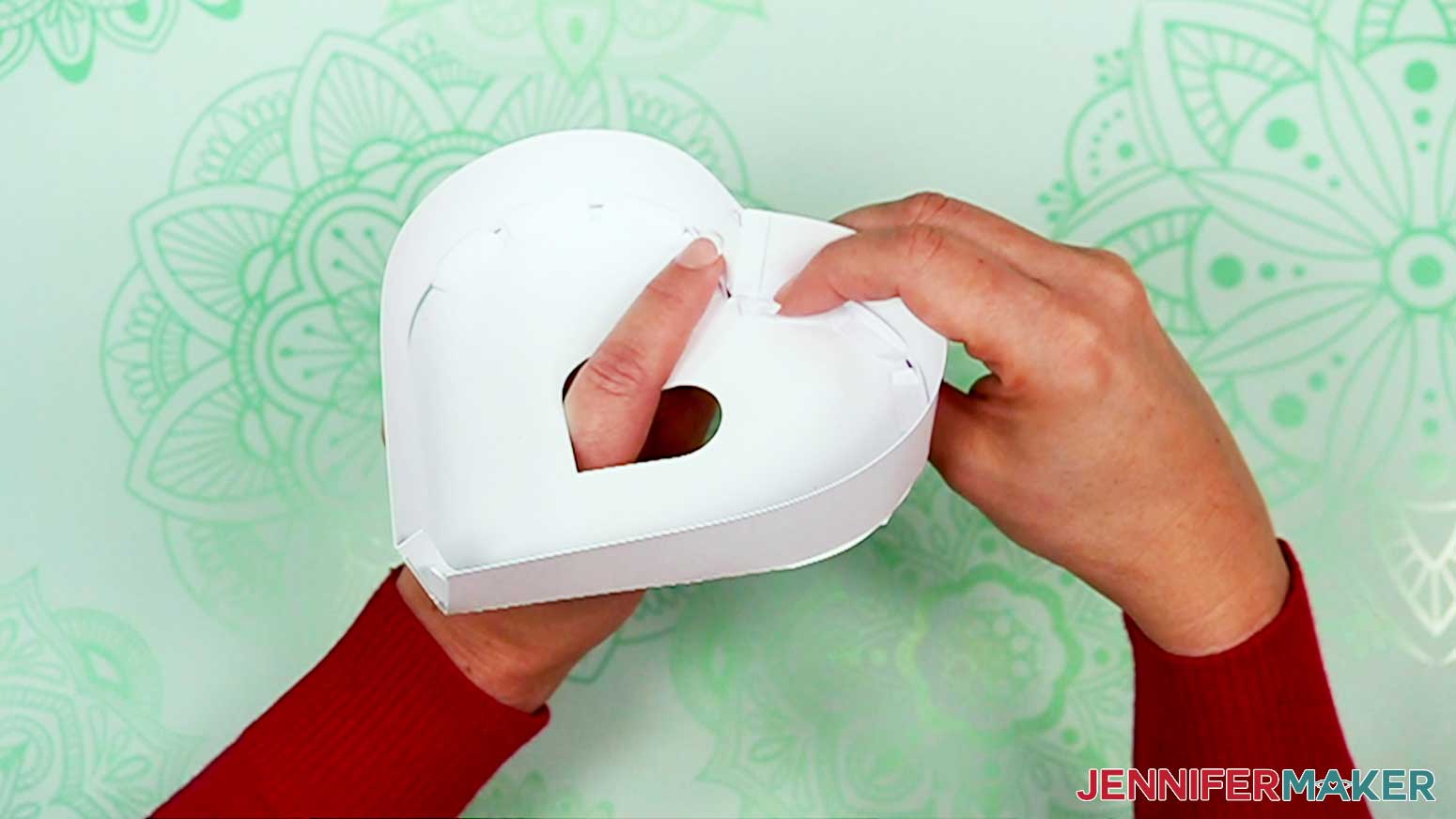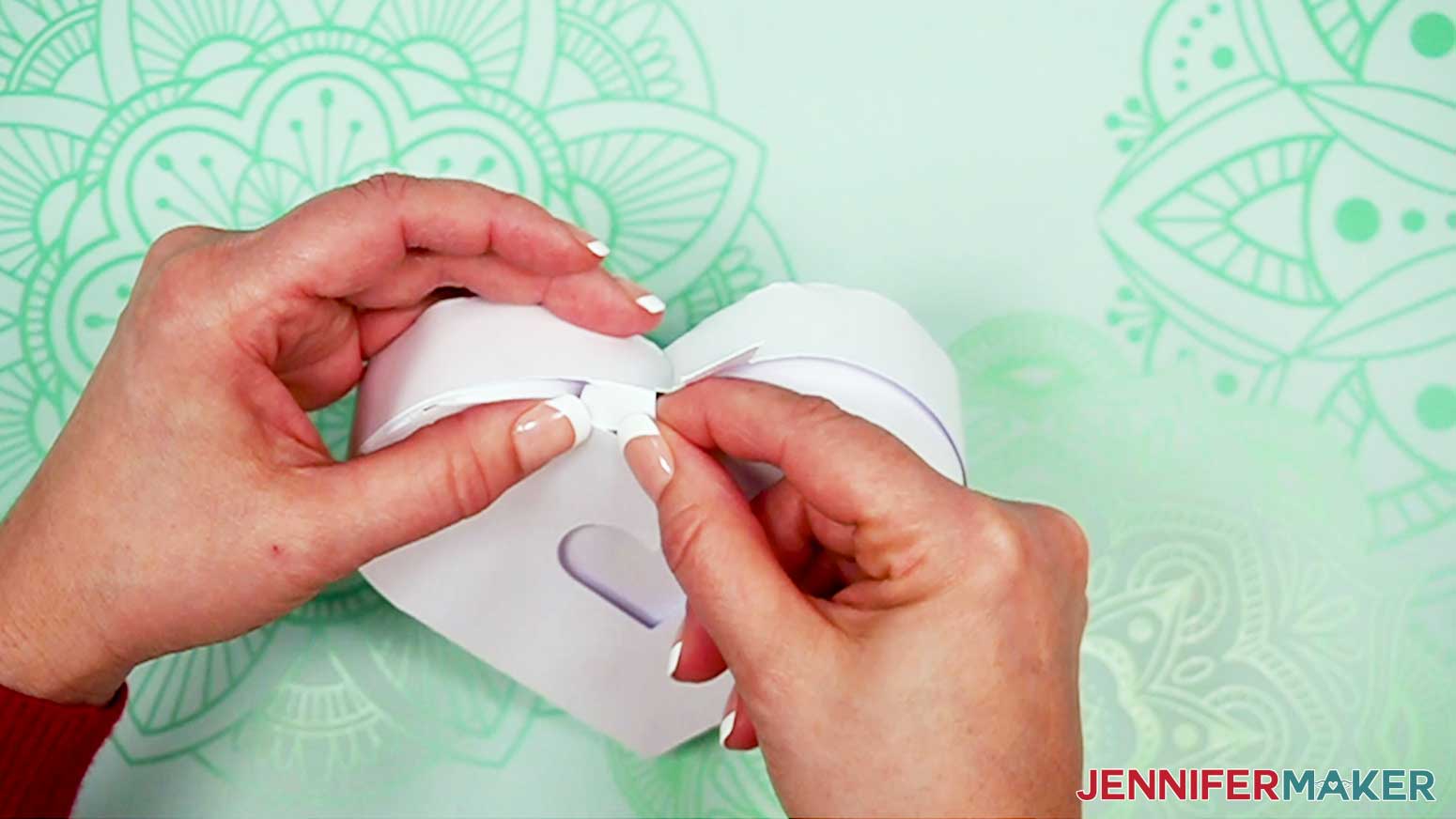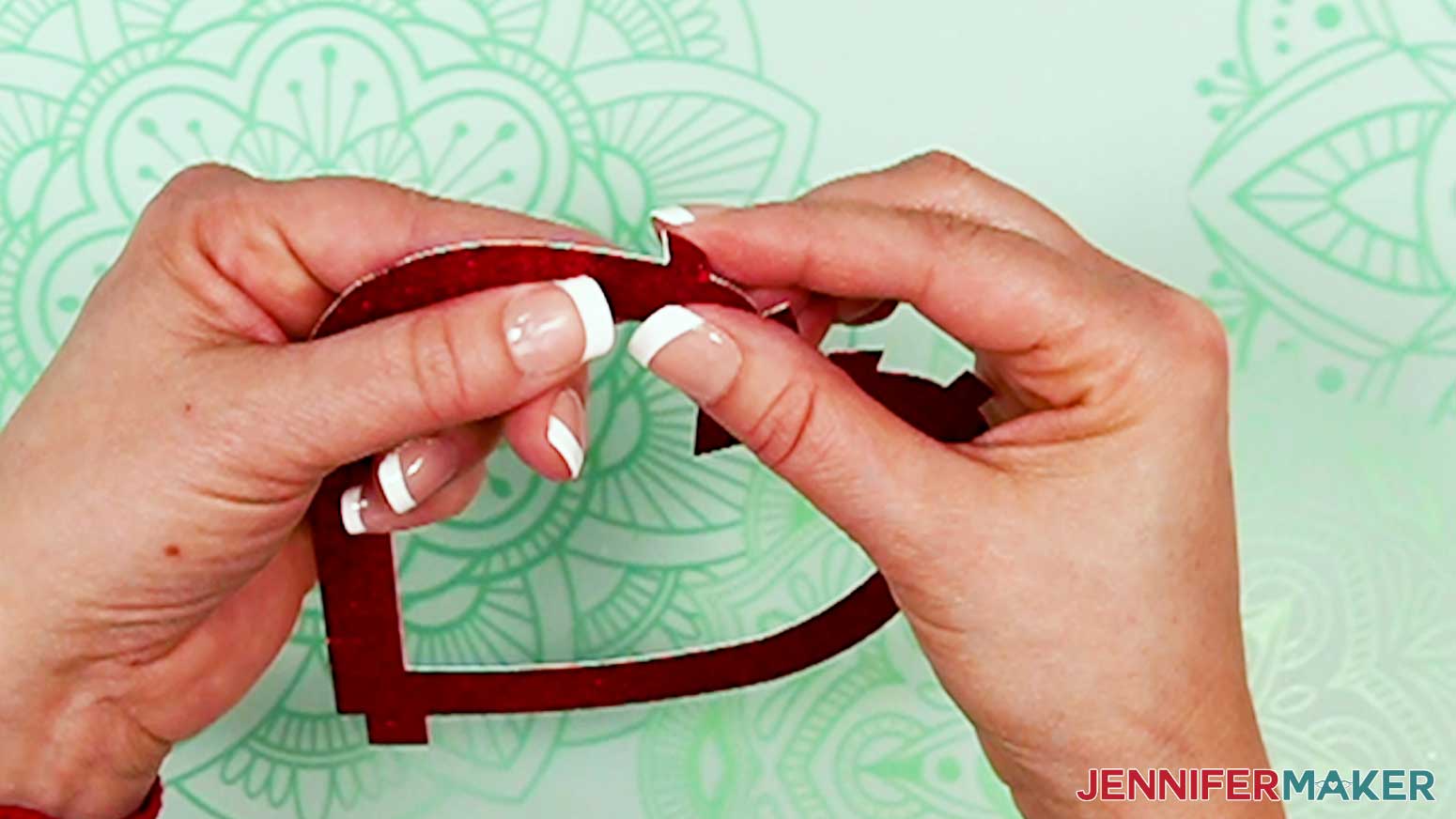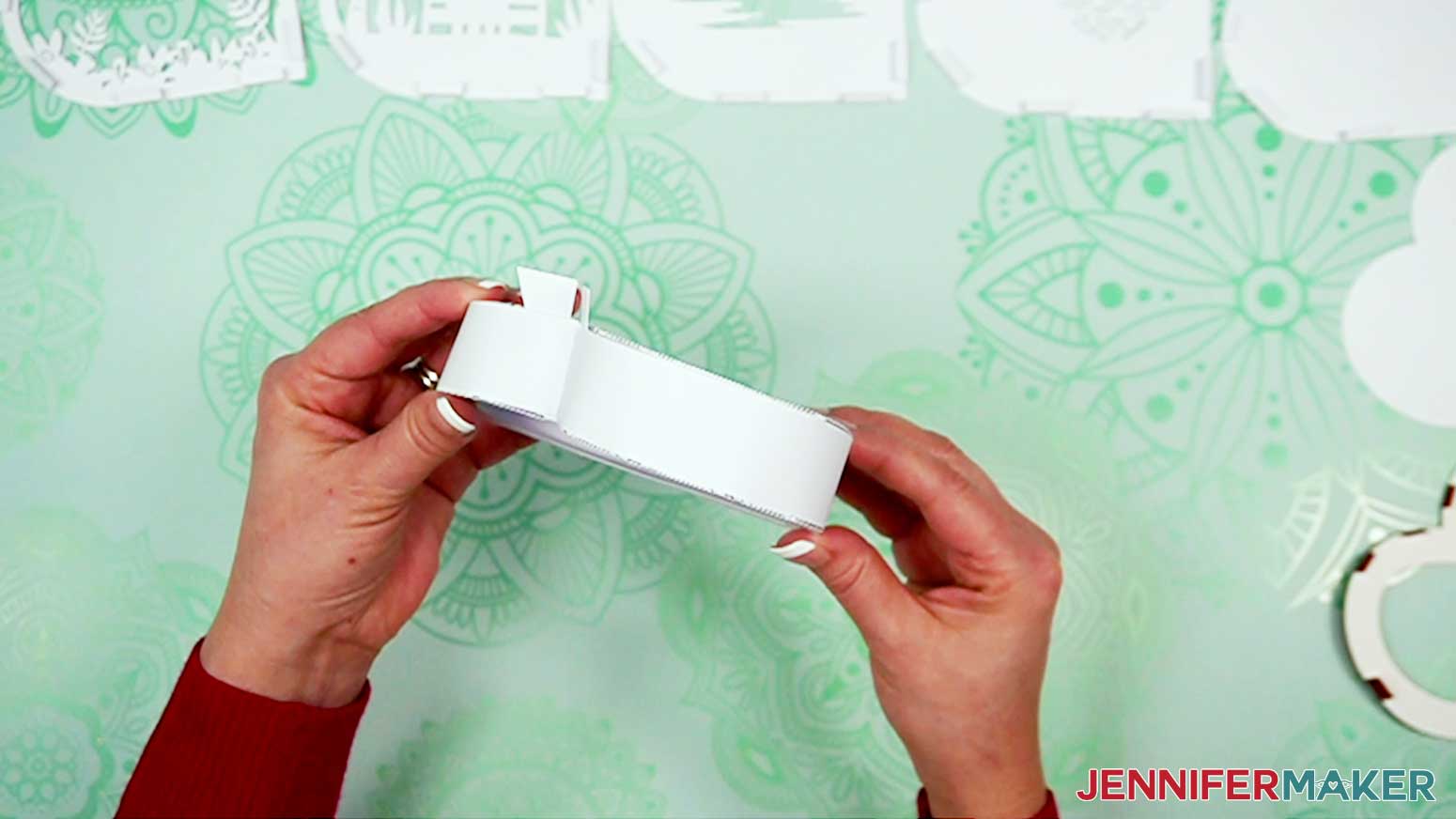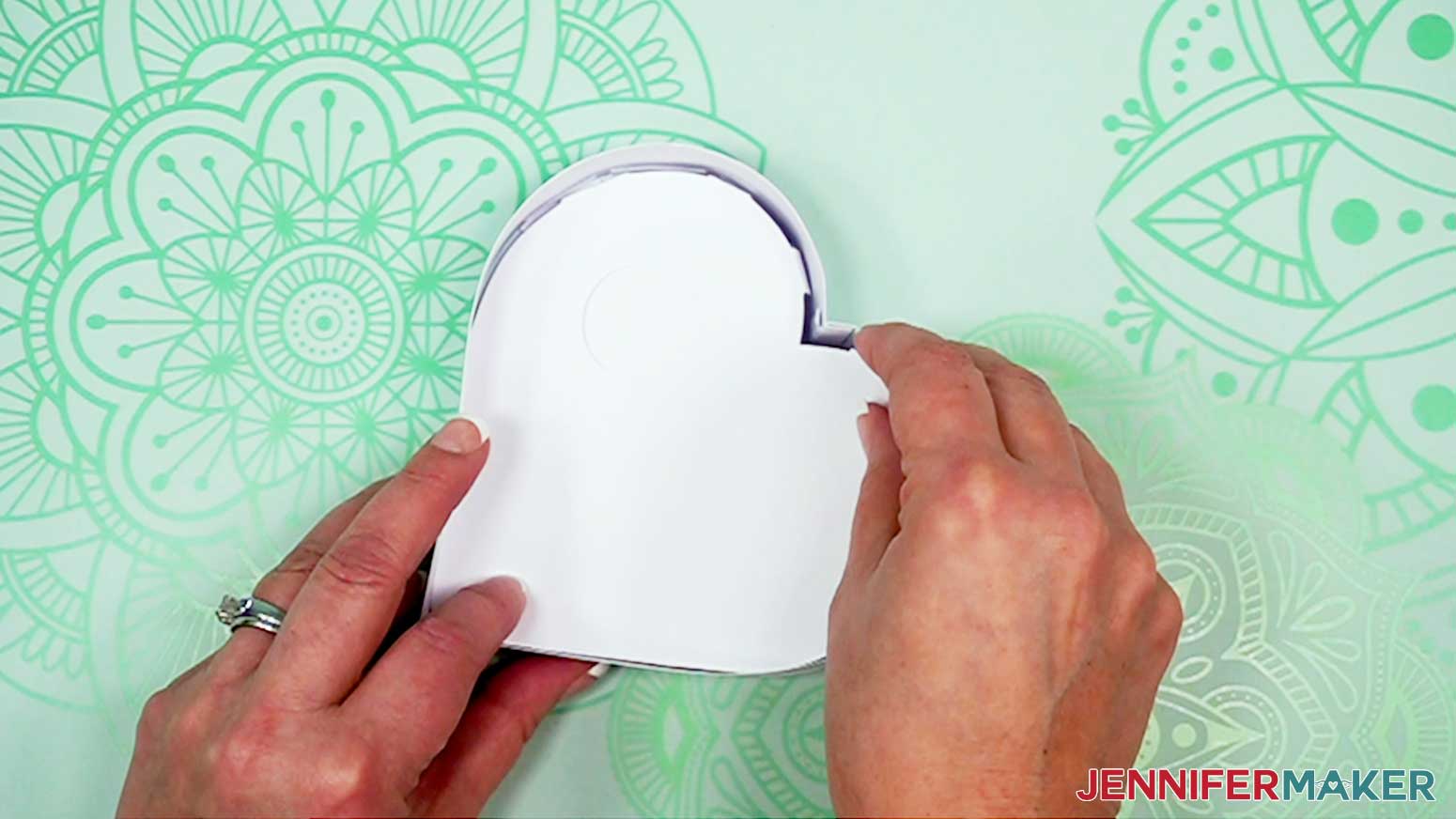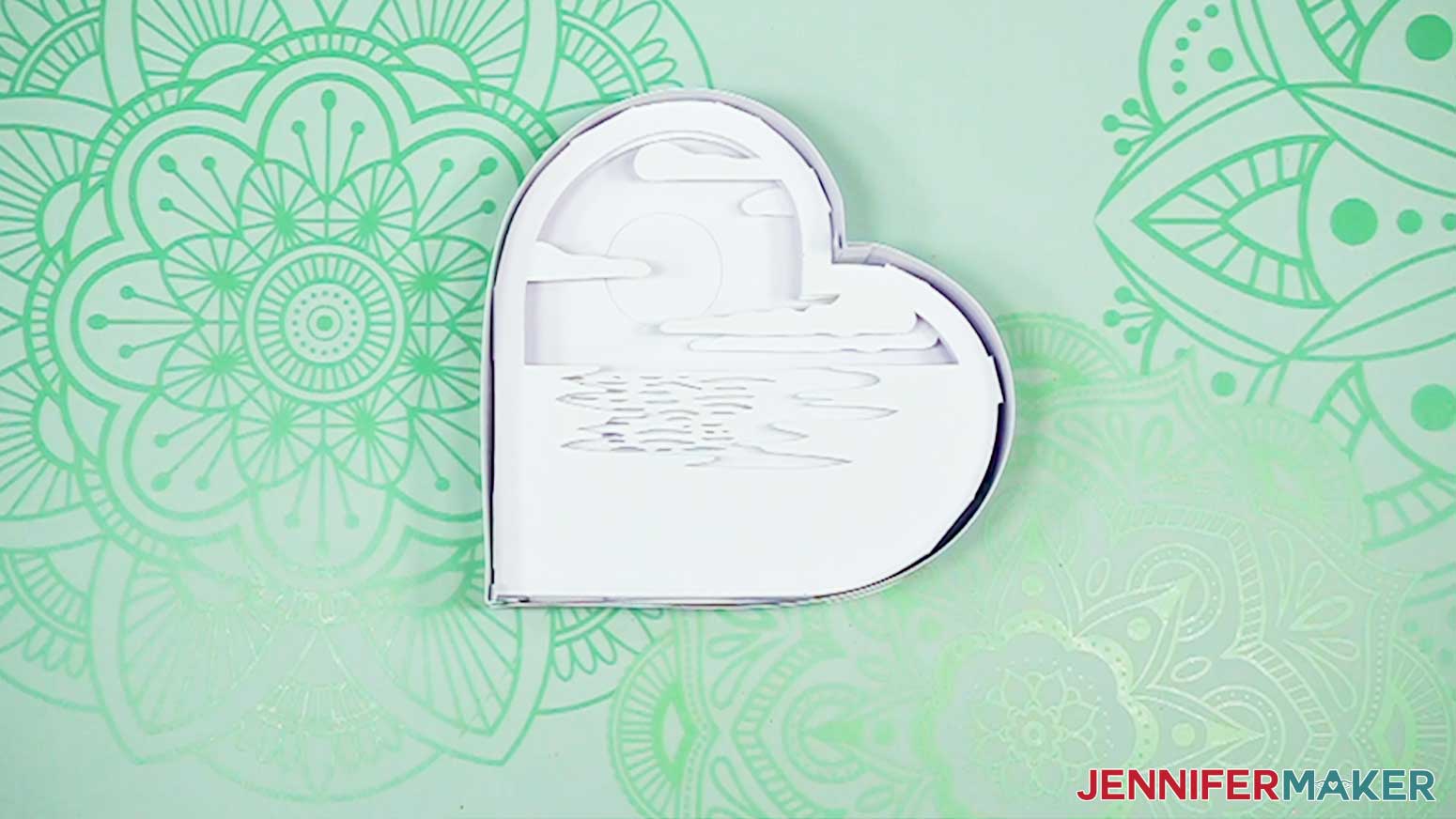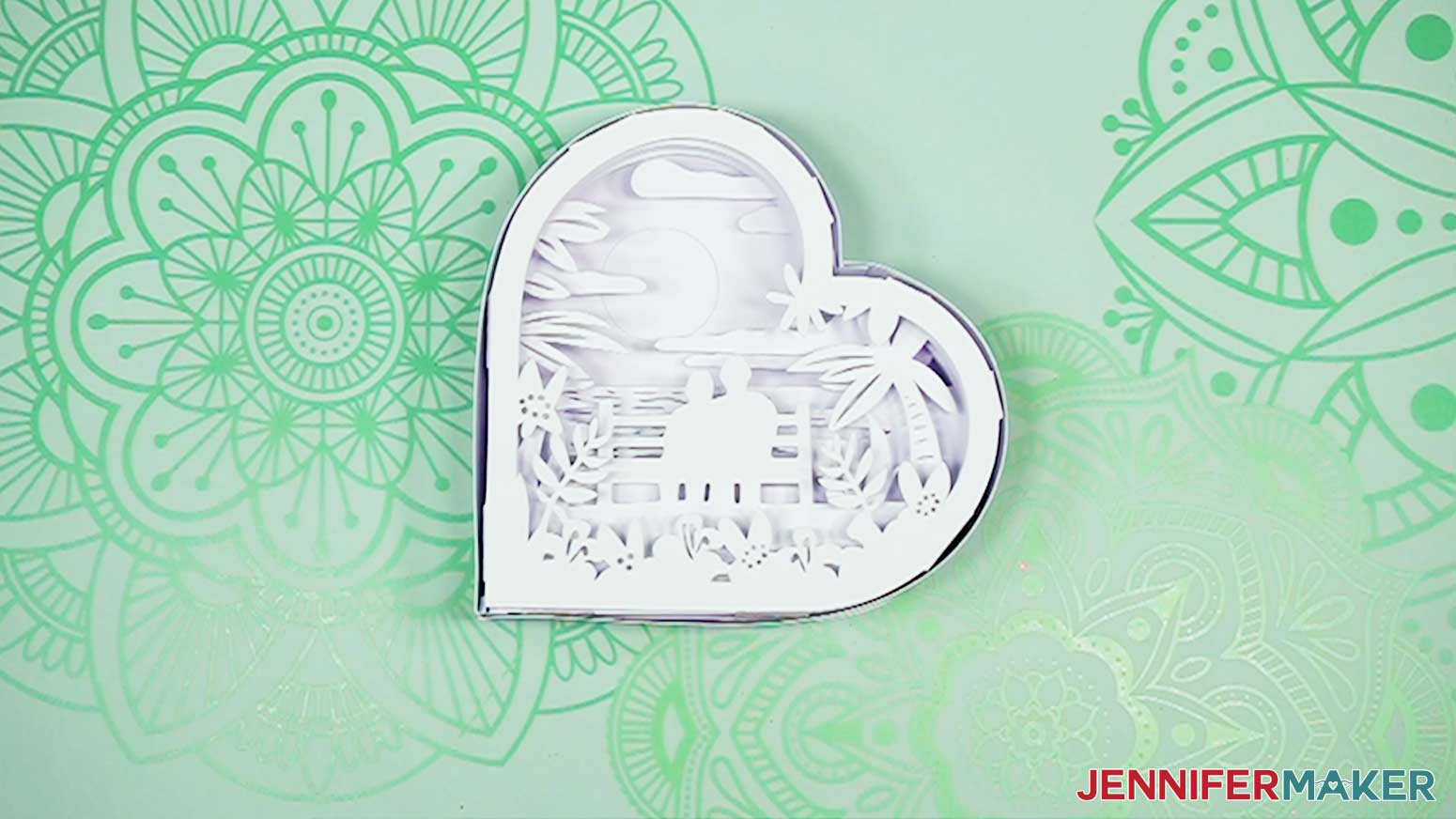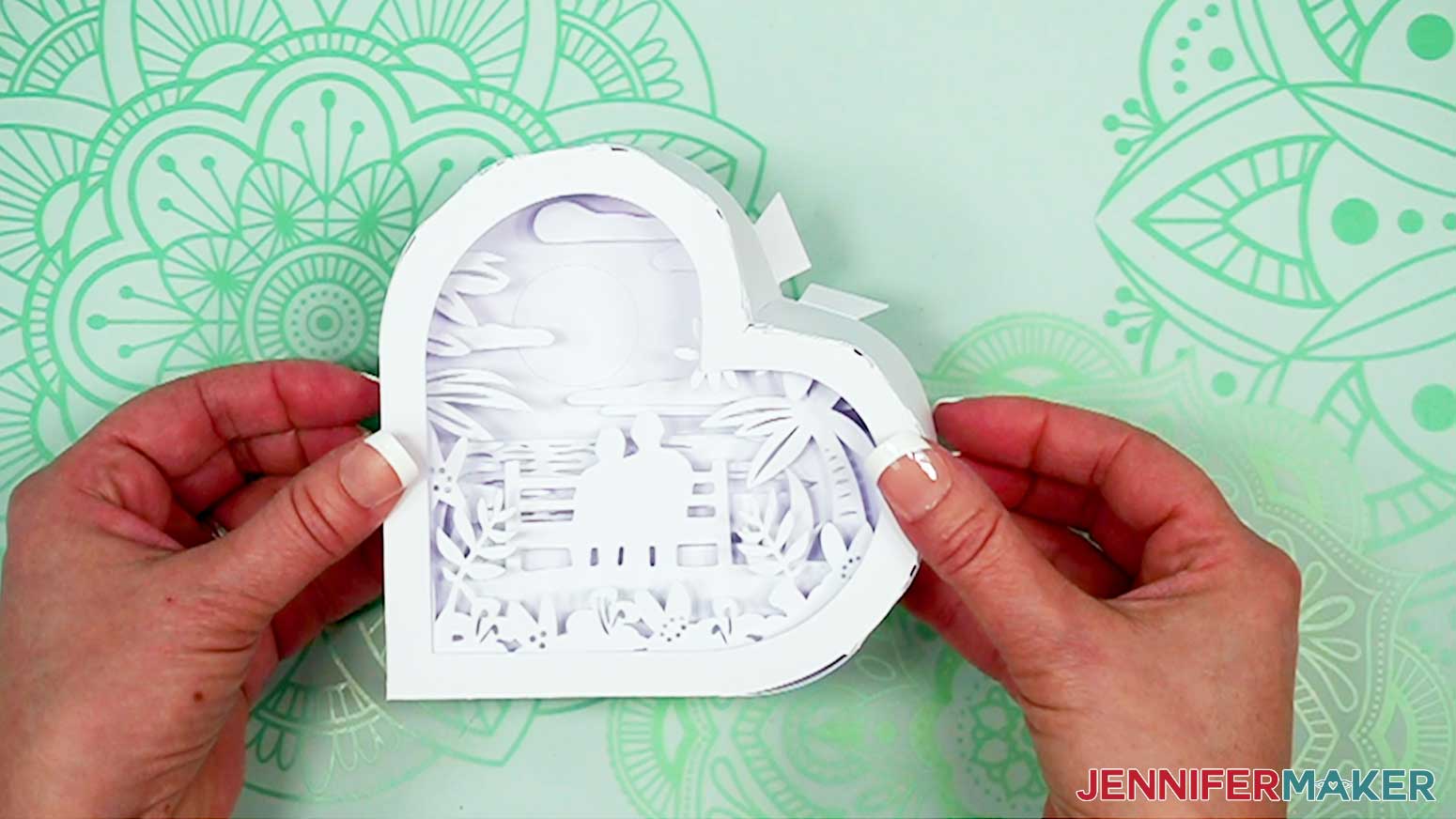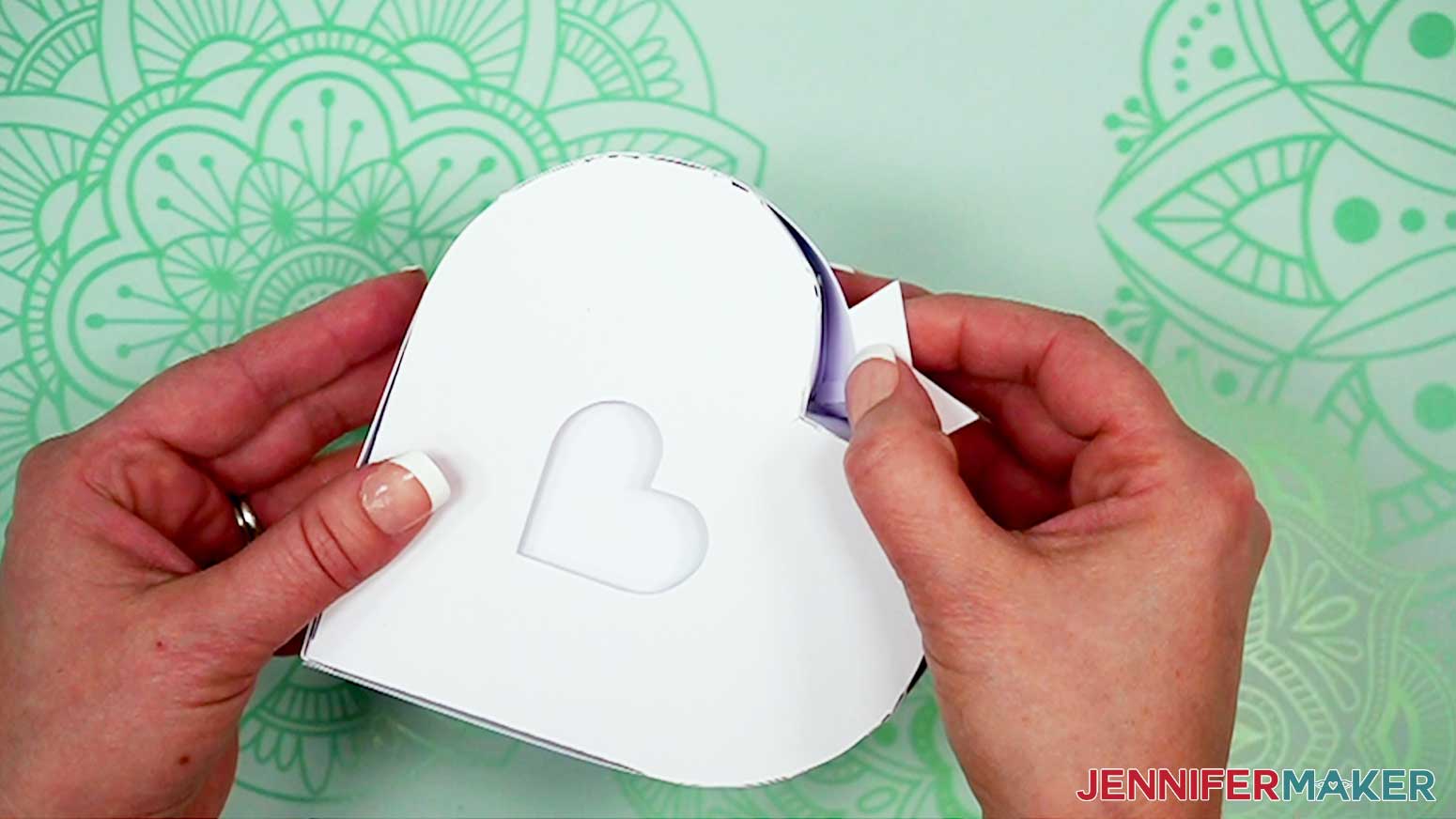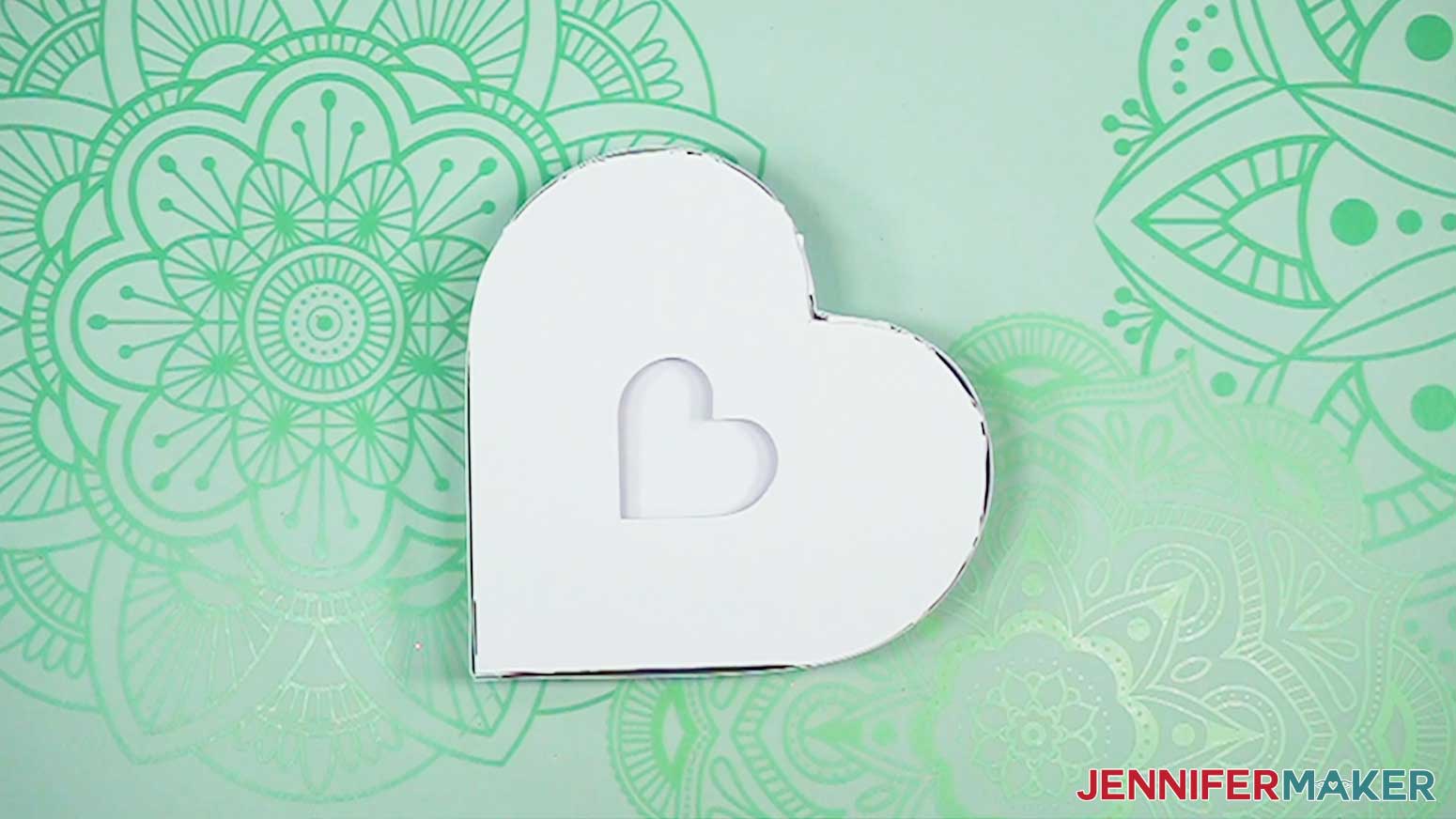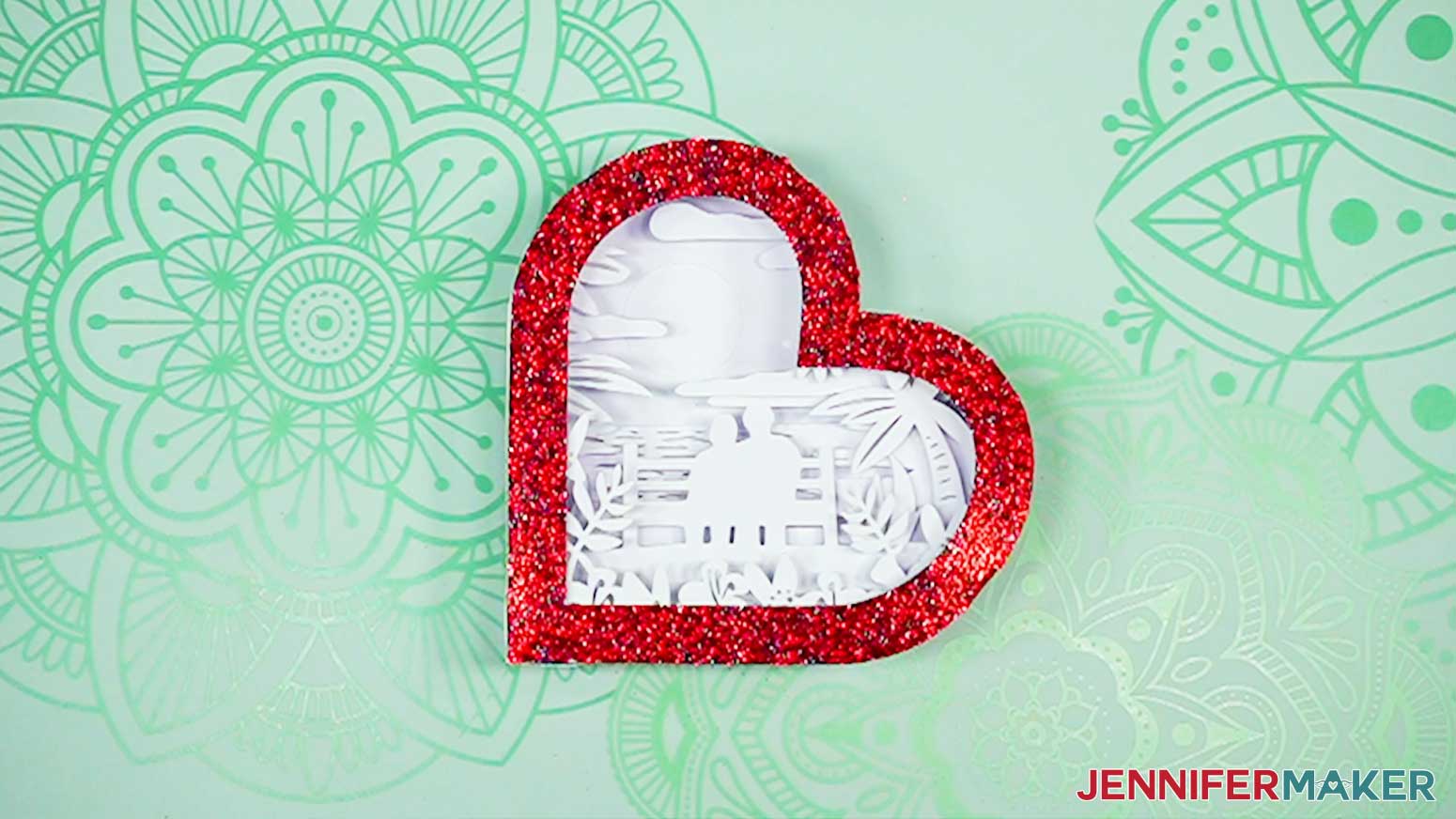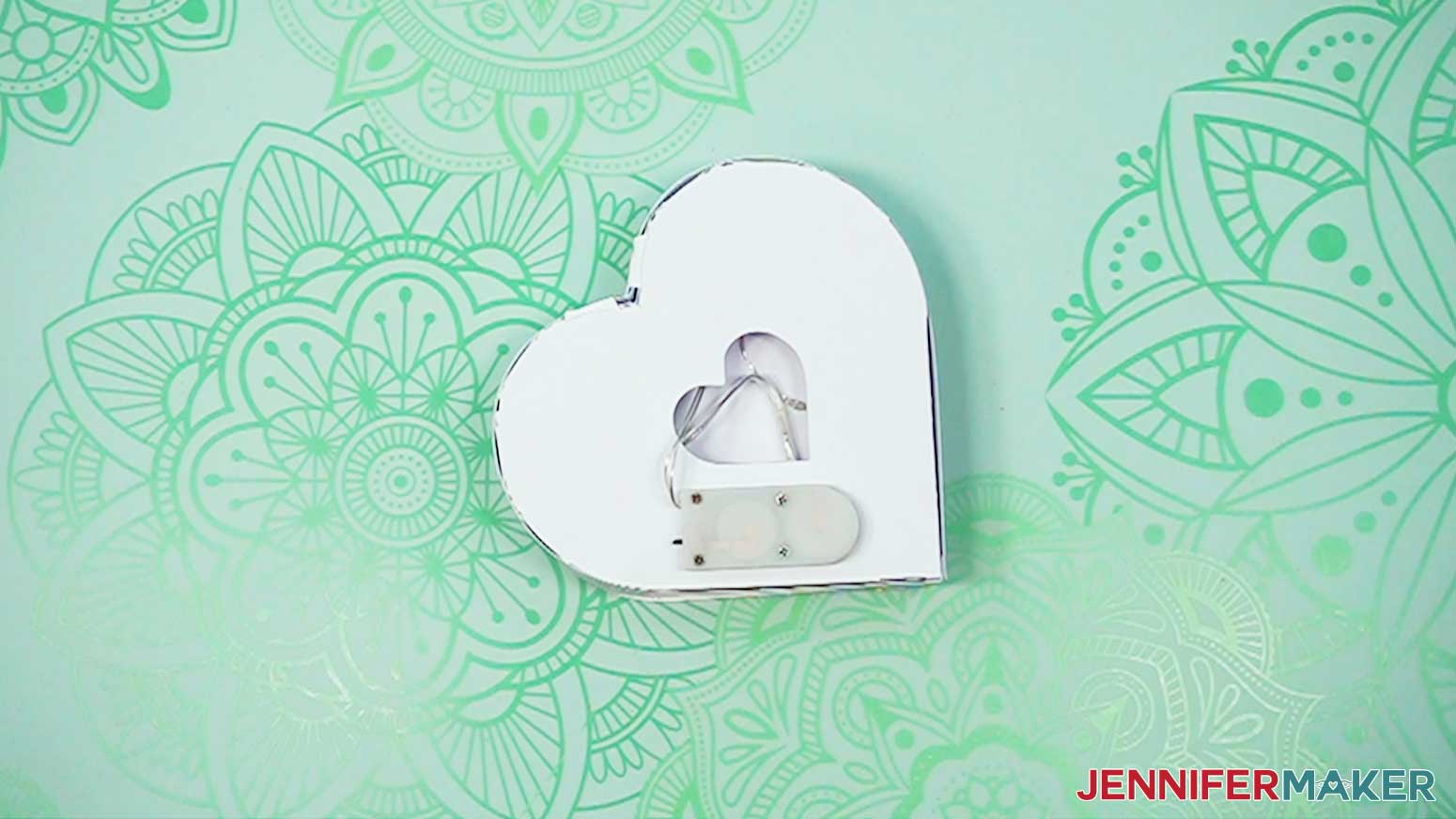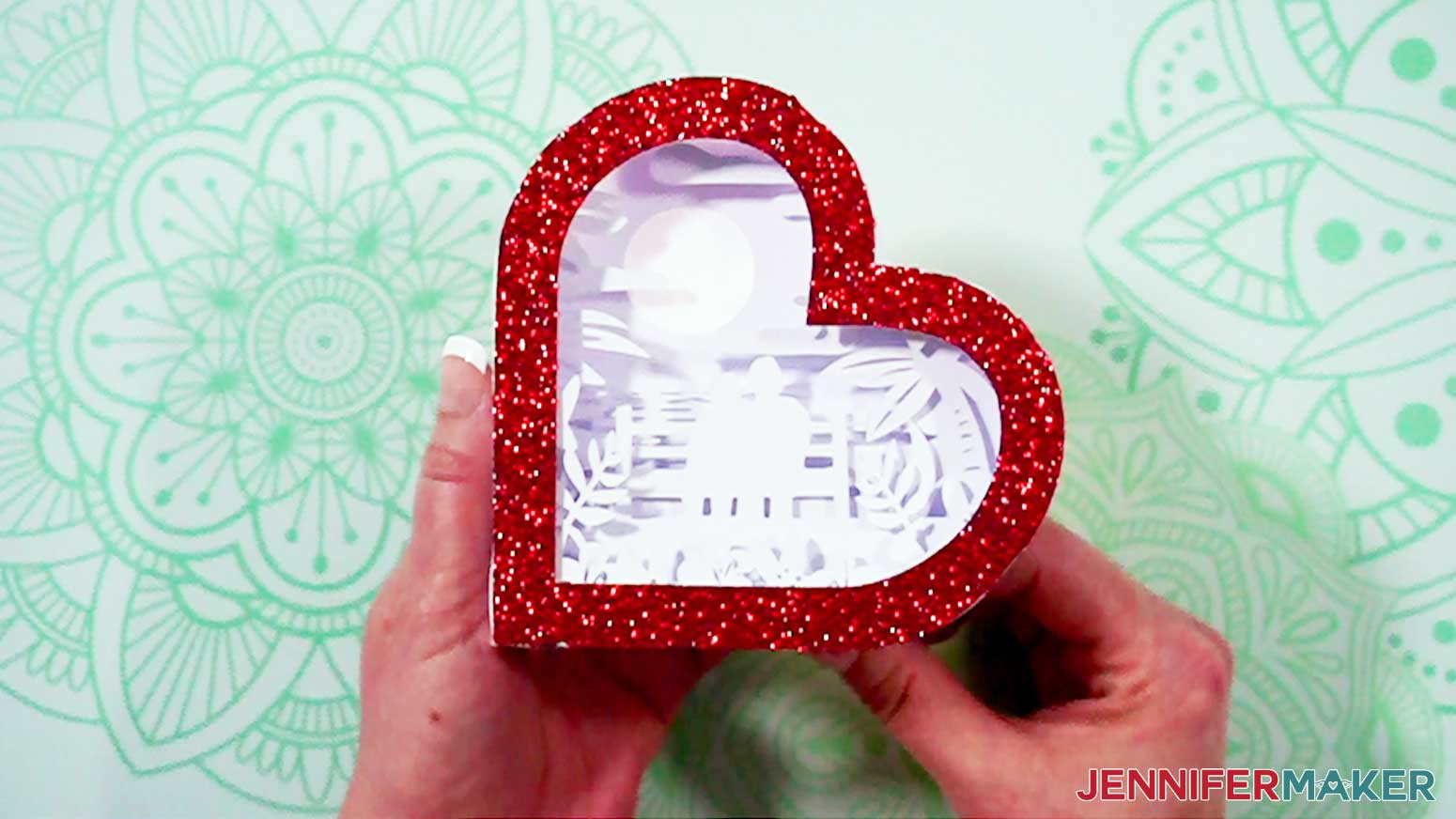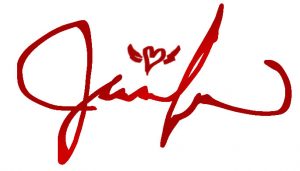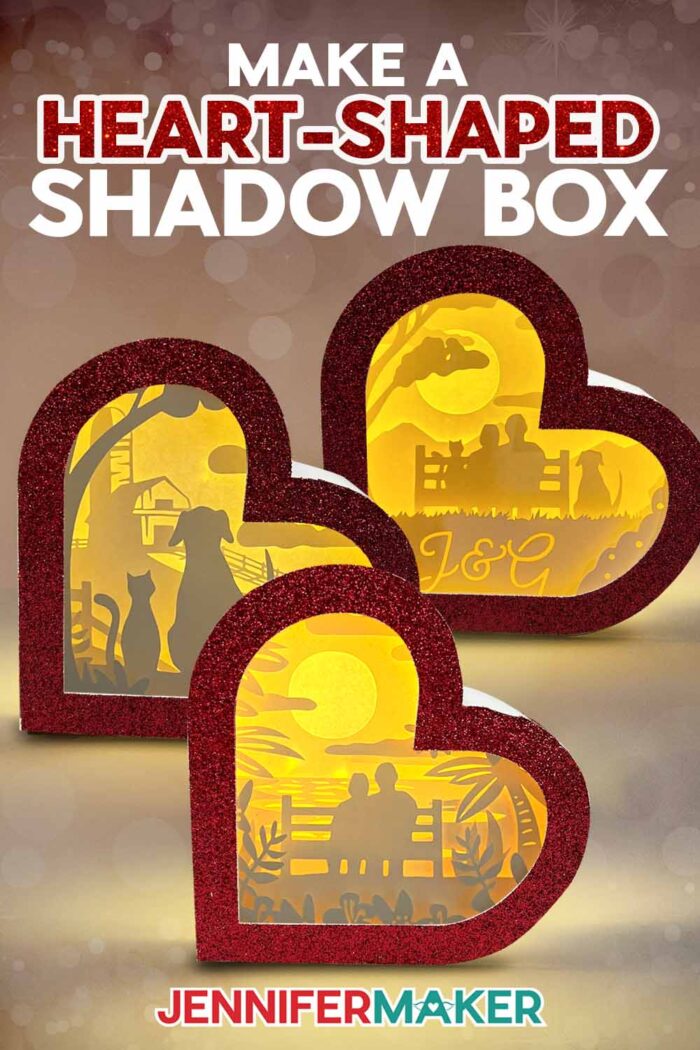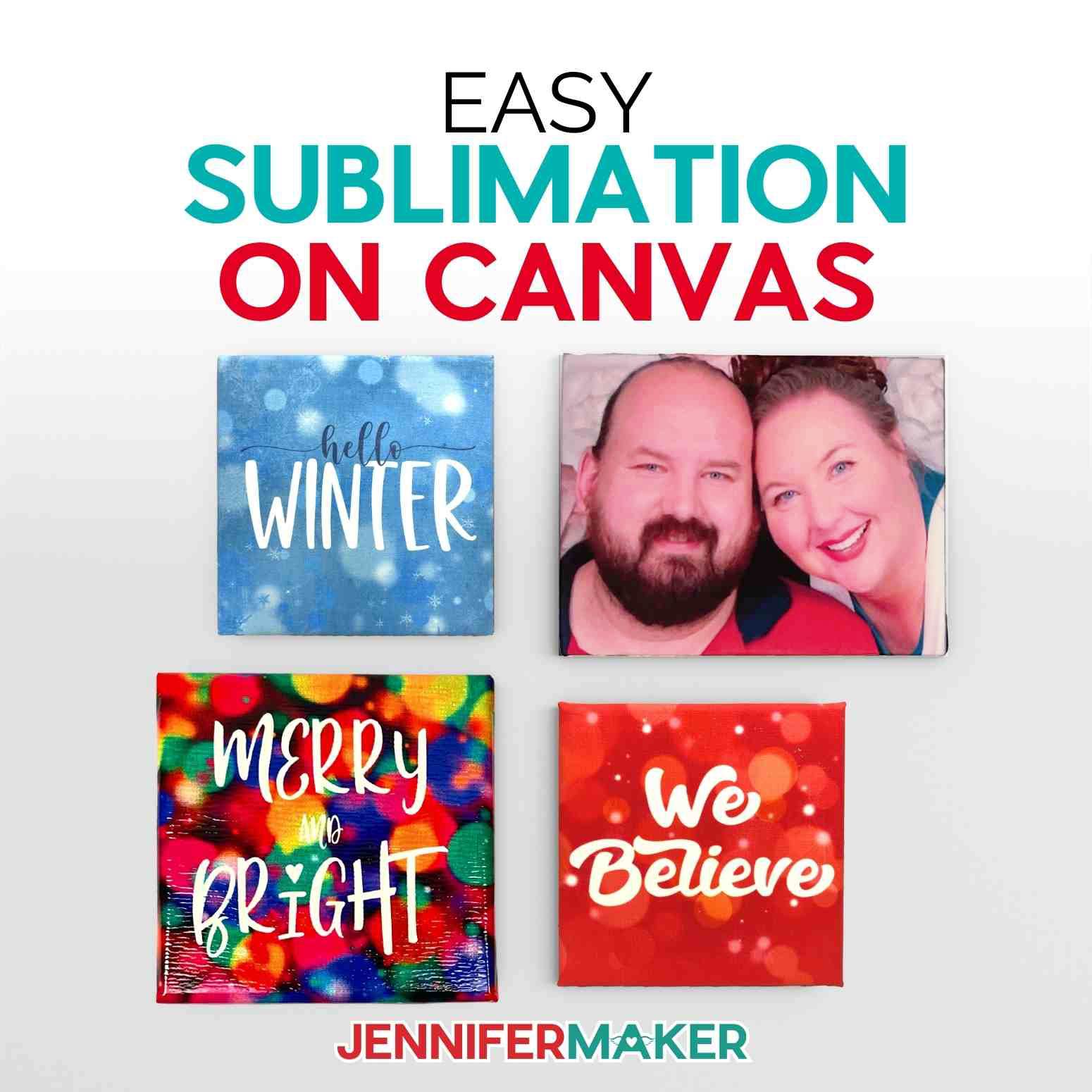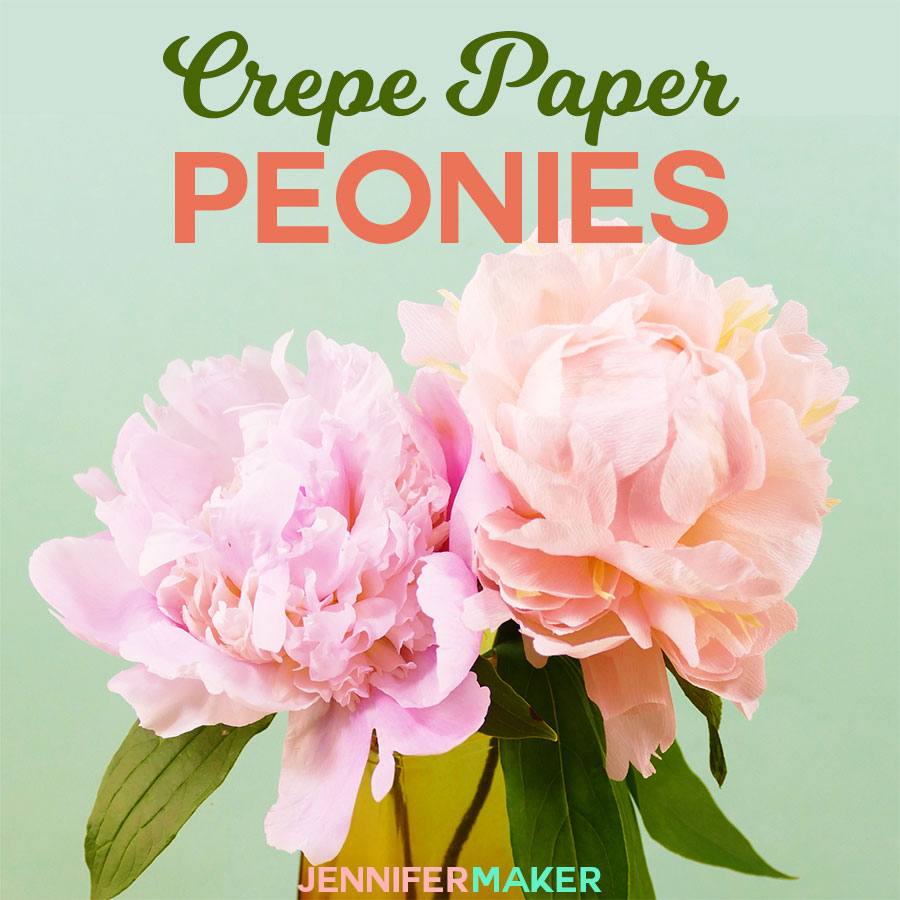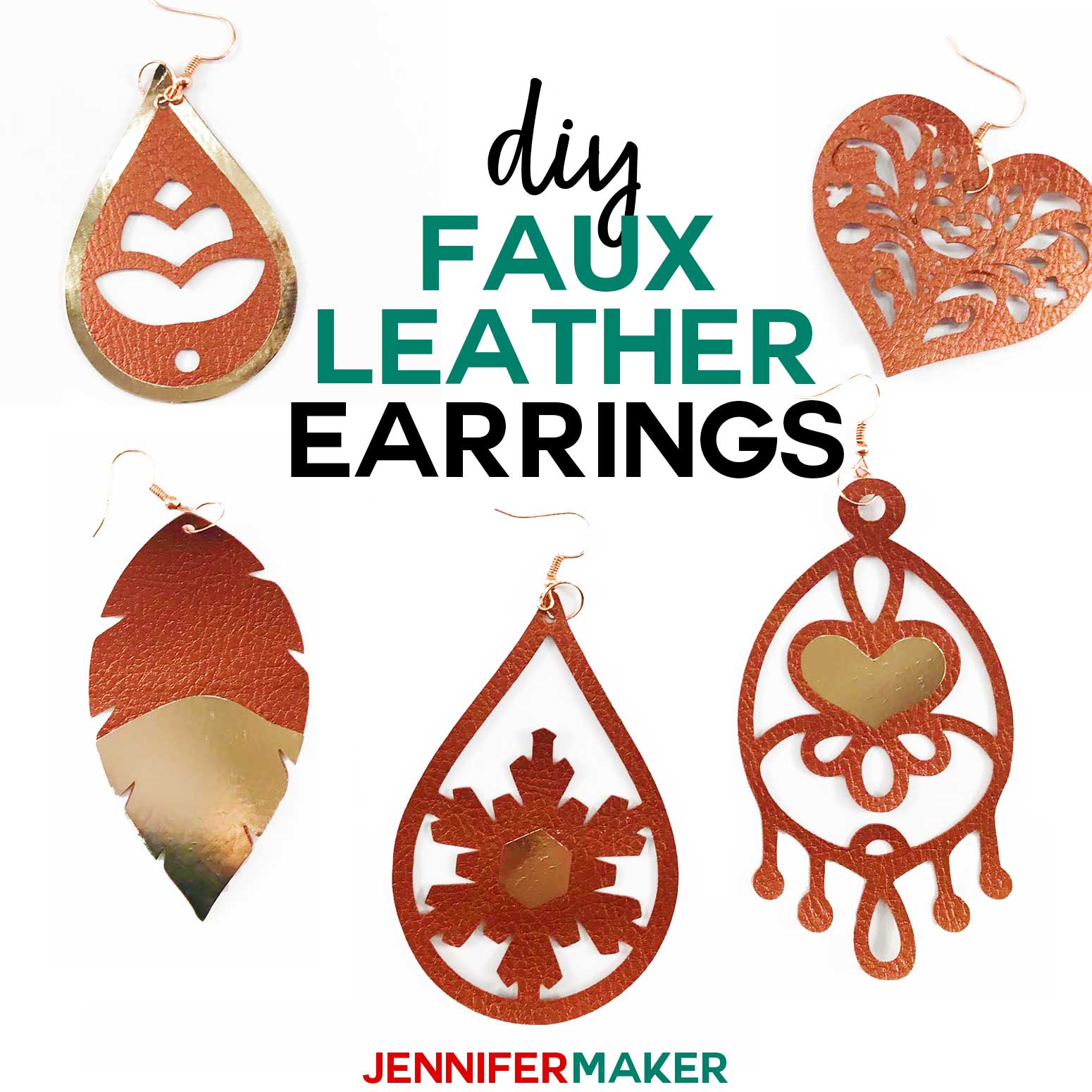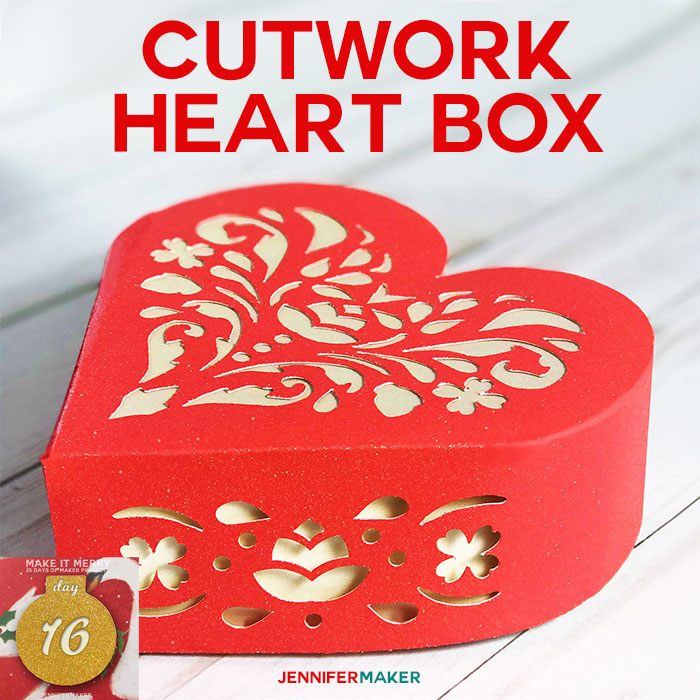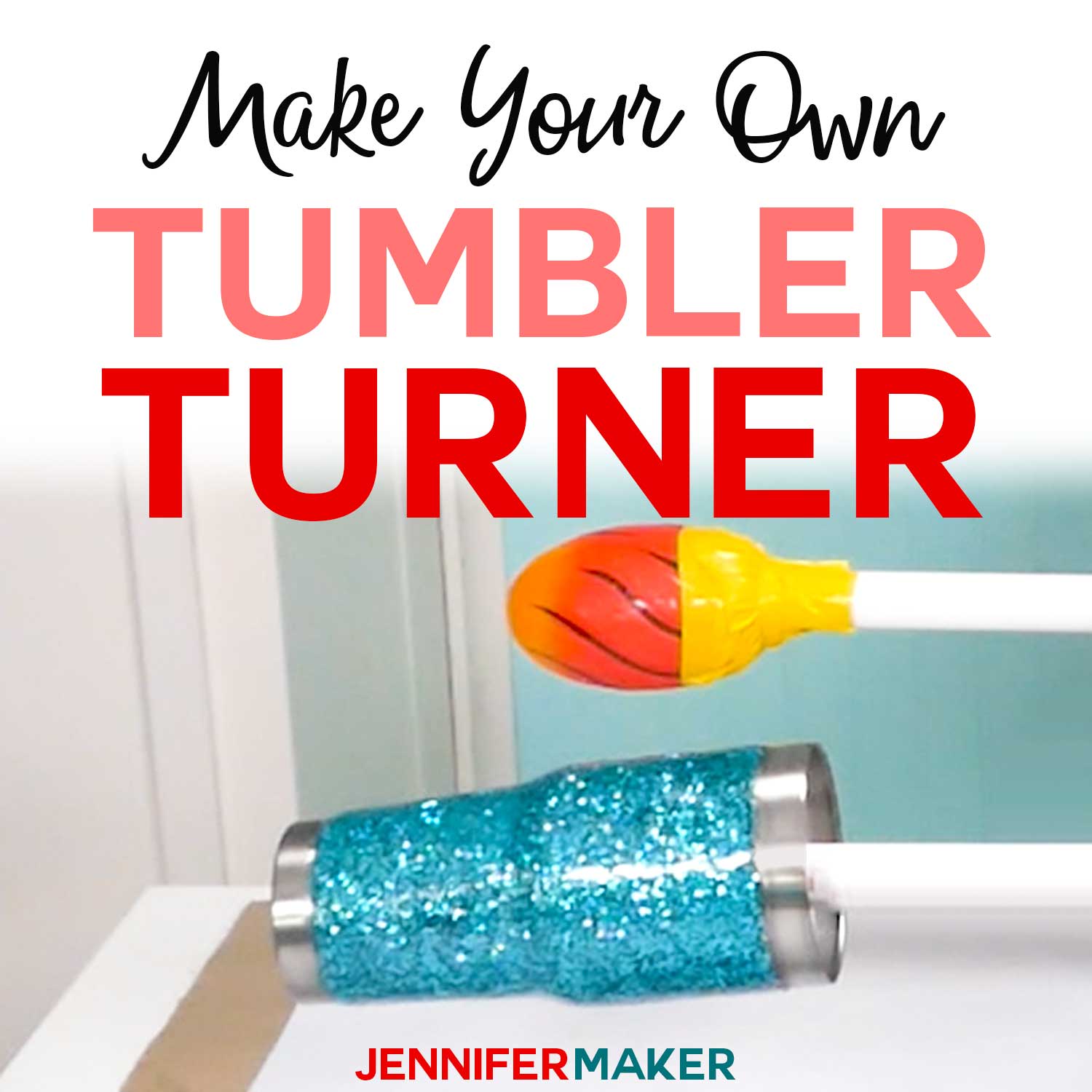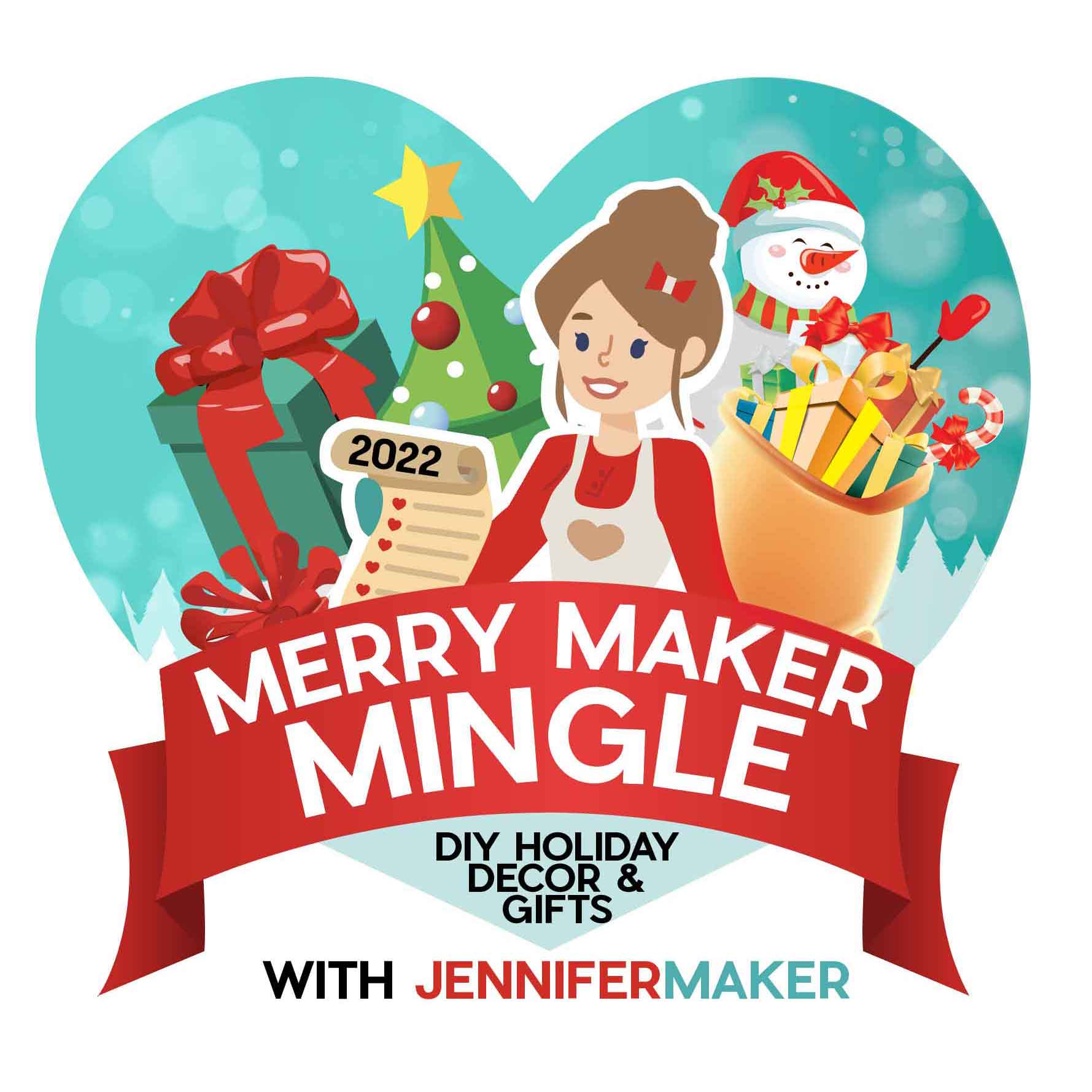Learn how to make a heart-shaped shadow box with only paper and some fairy lights!
We’ve already learned how to make circular and star-shaped shadow boxes, and they’ve been huge hits among my crafting community! I had a tons of fun designing and making them, but I got to wondering — Is it possible to make other shapes, too? The answer is yes! And what better time to create a heartfelt gift for that special person than now, with a beautiful and thoughtful Heart-Shaped Shadow Box. In this tutorial, I’ll show to make a thoughtful expression of your love with just a few pieces of cardstock and some LED fairy lights.
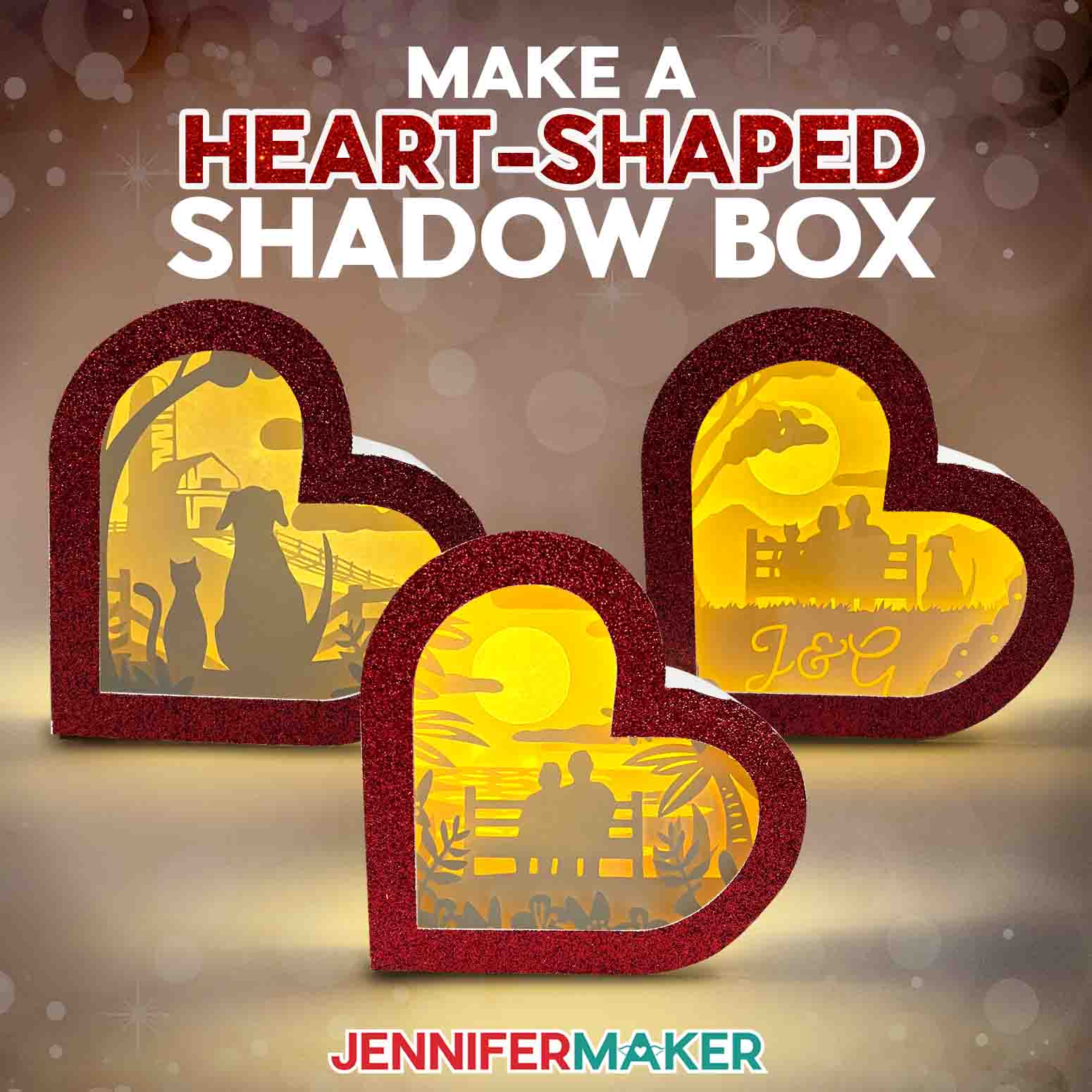
I can never get enough hearts! They’re my favorite symbol of love, and convey such a special meaning with just a cute little shape. With Valentine’s Day coming, I decided to take custom shadow boxes it a step further and create not one, but two new designs, each in the shape of a heart! They’re the perfect way to share some love this winter — whether as a symbol of your affection, a beautiful tribute to love itself, or just a cute piece of Valentine’s decor.
But how do you make a heart-shaped shadow box without a heart-shaped shadow box frame or picture frame? Well, you make your own! I designed this box with meticulous attention, but made it easy enough for you to cut and assemble in no time flat — without glue, tape, or any other adhesive. Just cardstock! Cool, right?
To make a heart-shaped shadow box, you only need a few basic supplies and tools, like some white 65 lb cardstock, a cutting machine like a Cricut, and (to really capture the essence of your love) a short strand of battery-operated LED fairy lights to make your heart-shaped shadow box glow from the inside out! I’ll show you how to prepare the no-score version so anyone can make it, but if you have a scoring tool (like a scoring stylus or single scoring wheel) I’ve included a version of the files for you, too.
Want your shadow box to stand out even more? Add an optional glitter, foil, or patterned cardstock accent frame to make your shadow box unique (and camouflage many of the tabs used to hold the shadow box together). With a custom frame color, there are truly endless options for creating unique shadow boxes with beautiful details and intricate design!
I recommend having a few hand tools around to help, too, like a craft spatula for lifting delicate cut areas, a scraper for removing tiny cutout bits from your machine mats, and a weeding tool — but not just for weeding. I’ll show you another way to use one in the tutorial that actually isn’t for weeding at all, but will help you get a nice, smooth finish on your shadow box assembly!
You can use my PDF files to cut these designs by hand, but I’ll use a Cricut Maker 3 today. You can also use an original Maker, an Explore series machine, a Cricut Venture, or another machine that uses cut files and can use twelve by twelve inch cardstock. If you’ve got a Cricut Joy Xtra, you can size the project down to work for your machine, too!
Small sentimental items like this can be a cherished keepsake for anyone, any time. Aside from being a unique way to gift a token of love for a valentine, you can give these as a Mother’s Day gift, anniversary gift, or give a beautiful gift to a special person just because! They can display your timeless keepsake for seasons to come, and have a constant reminder of the love and precious memories you share.
You can even make a bunch for your child to give as Valentines at school with custom names on the frame (depending on your time frame). Or you can place some along your fireplace mantel or use them to decorate your dining room table for a romantic dinner. My heart-shaped shadow box serves up the love no matter the occasion!
Ready to learn how to make a heart-shaped shadow box for someone special? This post contains some affiliate links for your convenience (which means if you make a purchase after clicking a link I will earn a small commission but it won’t cost you a penny more)! Read my full disclosure policy.
Materials And Tools to Make a Heart-Shaped Shadow Box
See my Amazon shopping list with exactly what I used!
- Three to seven (3-7) Sheets of 12″ x 12″ 65 lb. White Cardstock
- One (1) Sheet of 8.5″ x 11″ or 12″ x 12″ Glitter Cardstock (optional for the decorative accent frame, any weight)
- A way to cut your materials – I’m using the Cricut Maker 3, but you can also use the Cricut Maker, Cricut Explore Series machine, a Venture, or a Joy Xtra.
- Cricut Green StandardGrip Machine Mat 12″ x 12″
- Scoring Stylus -OR- Single Scoring Wheel (optional for files with score lines)
- Brayer
- Spatula
- Scraper
- Weeding Tool (for popping out small pieces from intricate areas)
- Tweezers (optional for handling delicate areas)
- Bearly Art Precision Craft Glue (optional)
- Design #584– My free SVG/DXF/PDF design files are available in my free resource library – get the password by filling out the form at the bottom of this page
How to Create a Heart-Shaped Shadow Box!
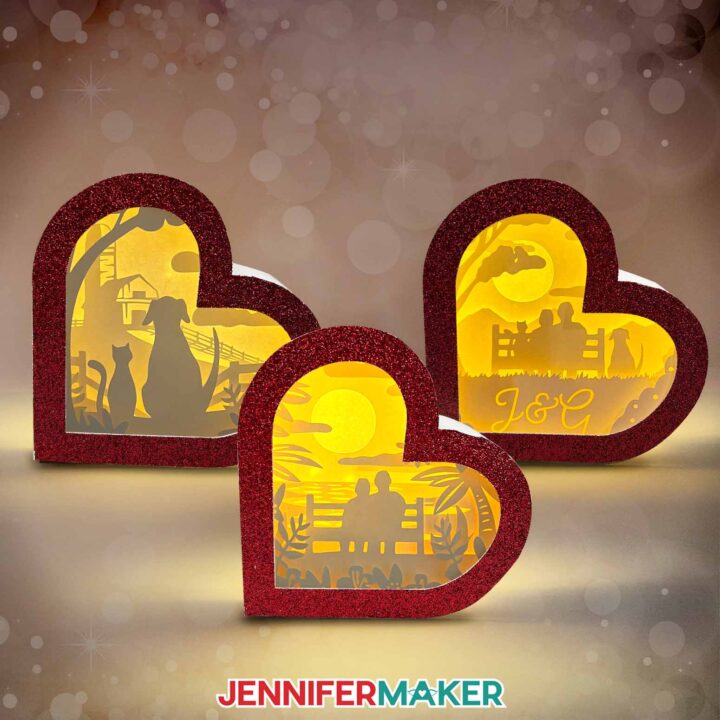
Heart-Shaped Shadow Box
Learn how to create a heart-shaped shadow box from just cardstock
Materials
- Three to seven (3-7) Sheets of 12" x 12" 65 lb. White Cardstock -OR-
- One (1) Sheet of 8.5" x 11" or 12" x 12" Glitter Cardstock (optional for the decorative accent frame)
- One (1) 3.3' Strand of LED Fairy Lights
- Design #584 (My free SVG/PDF/DXF design files are available in my free resource library - get the password by filling out the form at the bottom of this page
Tools
- A way to cut your cardstock - I’m using the Cricut Maker 3, but you can also use the Cricut Maker, a Cricut Explore Series machine, the Cricut Joy Xtra, or the Cricut Venture
- Cricut Green StandardGrip Machine Mat 12" x 12"
- Scoring Stylus (optional for files with score lines) -OR-
- Single Scoring Wheel (optional for files with score lines)
- Brayer
- Spatula
- Weeding Tool
- Scraper
- Small 3/16" Zots Glue Dots (to attach the light's battery box)
- Scotch Tape (optional)
Instructions
STEP 1: GET MY FREE HEART-SHAPED SHADOW BOX DESIGNS
First, download my Heart-Shaped Shadow Box designs from my free library -- look for Design #584. Alternatively, you can use the Save This Project form near the top of this post and the design link will be emailed to you.
In the SVG folder, you’ll find score and no-score versions of my “Beach” and “Barn” heart shadow box designs to cut on a cutting machine. There is also a DXF folder with cut files, and a PDF folder with versions you can print and cut by hand.
Upload the SVG file you need to Design Space to get started. I’ll demonstrate with the score “Beach” shadow box design.
TIP: If you’re not sure how to upload, go to jennifermaker.com/svgs to learn how to unzip and upload SVG files.
STEP 2: PREPARE YOUR HEART-SHAPED SHADOW BOX DESIGN
CRICUT DESIGN SPACE
- Open Cricut Design Space and click “New Project.”
- Click “Upload” and then “Upload Image.”
- Click “Browse.”
- Select the SVG file.
- On the Prepare to Upload screen, it will say “Cut Image” with the design preview.
- Click “Upload.”
- Find your design in Recent Uploads and add it to the Canvas.
- Ungroup the design.
- If you do NOT want to use the red accent frame piece, delete or hide it now.
- If you’re using a file WITHOUT score lines, the file is ready to cut. Skip ahead to step 15.
- If you’re using a file WITH score lines, find a group of two layers and select the top layer with just lines.
- Change it to “Score” in the Operation menu.
- Click the group to select both layers, then click “Attach.”
- Repeat steps 11-13 with the remaining two-layer groups.
- Make sure the correct machine is selected in the top right.
- Click “Make.”
- If prompted, click “On Mat,” choose your mat size, and click “Confirm.”
- On the Prepare screen, make sure the correct Material Size is selected for your materials.
- You can combine mats to save materials if you want. Click the three dots on elements to move them and reduce your mats.
- Select the first mat again and click “Continue.”
- You may be prompted to save your project. Type in a name and click “Save.”
CUTTING
- On the Make screen, set the Material for your white mats to “Medium Cardstock - 80 lb (216 gsm).”
- Change the Pressure to “More” for a cleaner cut.
- If you’re using the “no score” version, skip ahead to step 4. If you’re using the Scoring Stylus, insert it into the clamp now. If you’re using the Single Scoring Wheel, insert it into the clamp when prompted.
- Place your first mat’s cardstock face up on a green StandardGrip machine mat.
- Use a brayer to make sure it’s fully adhered.
- Check that your Premium Fine-Point Blade is clean and in the clamp.
- Press the flashing “Load/Unload” button to load the prepared mat into your Cricut.
- Press the flashing “Go” button to begin cutting.
- When it has finished cutting, unload the mat, flip it over onto your work surface, and roll it back to release the paper.
TIP: Use the spatula to help lift delicate parts, and the weeding tool to poke out small bits of cardstock that may have been left behind. If you have any issues with your cuts, check out my Tips for Cleaner Cuts. - Use a scraper tool to remove the small bits left on your mat after you remove the cut pieces.
- Follow steps 4-10 to continue cutting the rest of your white cardstock mats.
NOTE: If you’re cutting the optional glitter cardstock frame piece, select the “Glitter Cardstock” base material setting and choose “More” Pressure on that mat. - Lay out all of the cut pieces face up. Refer to the Design Space screen if you’re not sure on some pieces.
STEP 3: ASSEMBLE YOUR HEART-SHAPED SHADOW BOX
- Find the bottom-most plain white cardstock inner layer piece with tabs. If you’re making the “Beach” design, it has a circle cutout. If you’re making the “Barn” design, it’s the solid heart piece.
- With the piece face up, fold one of the ten tabs back on the scored or dashed line where the tab meets the frame.
TIP: Try to make the creases as straight as possible. Use the scraper tool to help. - Fold the next score line on the same tab back.
- Fold the last score line on the tab back.
TIP: Your tab should resemble a rolled triangle or square shape. Use your fingers to pinch it together so it stays rolled. - Repeat steps 2-4 with the other nine tabs on the layer.
- Repeat steps 1-5 with the other four white cardstock layer pieces.
- Find the heart-shaped frame piece with a small heart cutout and long strips on each side and place it face up. This is the back or bottom of the shadow box.
- Fold the strip back on one side, along the scored or dashed line on the side of the heart.
TIP: It’s important to make these creases very straight, so use your scraper tool to help if needed. - Repeat step 8 with the other strip on the other side of the heart.
- Find the four tabs that run along the side of one of the strips, and fold them down.
- Find the tiny tabs (I’ll call them “wings”) on either side of each folded tab, and fold them down in the same direction.
- Repeat steps 10-11 with the tabs (and wings) on the other strip.
- Find the scored tabs at the very end of the TOP part of each strip. One has wings, and the other has a slot.
- Fold each of the tabs in the same direction as the tabs along the side of the strip.
- Fold in the wings on the one tab the same way.
- At the bottom point of the heart, fold both tabs in toward the heart.
- Fold the wing tabs inward toward the heart.
- Around the top edge of the heart shape, fold the tabs in the same direction as all the other tabs.
- Beginning on the outside and moving inward, insert one strip’s tabs into the slots in the tabs around the edge of the heart in order, unfolding the wings and flattening the tabs as you go.
TIP: If you have trouble unfolding the wings, your weeding tool can help. Just gently poke the tip under the wing to pull it up, then smooth it down. - Repeat with the other strip’s tabs on the opposite side of the heart.
- Insert the last tab at one side of the heart’s top point into the slot on the opposite tab.
- Unfold the wings and flatten the tabs.
- Tuck the end of the tabs underneath the flaps around the top of the heart’s edge to help the box fit together more easily when it’s time to put everything together.
- Insert the last tab at one side of the heart’s bottom point into the slot on the opposite tab.
- Unfold the wings and flatten the tabs.
- Pinch the top point from the inside to crease it well.
- Repeat step 26 with the bottom point, pinching from the outside.
- Repeat steps 7-27 with the front/lid of the box (the other heart frame piece with a large heart cutout and strips on either side).
- Find the angular tab next to the end tab, and fold it in toward the end tab’s fold.
- Find the front accent piece. If you cut your pieces from the same materials as I did, this piece will be made from glitter cardstock.
- With the front (glitter side) facing you, fold the eight tabs back.
- Lay out your pieces face down on your work surface, all in the same orientation.
- Try to put the front and back box pieces together to form the box. The piece with the small heart cutout is the back of the box, and the piece with the large heart cutout is the front.
TIP: If you have trouble fitting the two pieces together, try smoothing down the tabs inside again, or adding small pieces of clear tape to hold them down. - Separate the front and back pieces.
- Lay the back piece in front of you, face down so you can access the open area where the layers will go.
- If you’re using the layer with the sun/moon circle cutout, lay the solid heart piece inside it, between the folded tabs.
- Turn the layered pieces over and insert them into the back box piece, with the supports facing down.
NOTE: If you’re not using the sun/moon layer, insert the solid heart layer into the back box piece by itself.
TIP: Don’t try to put your lights in now – those go in at the end. - Find the piece with the water, clouds, and reflection.
- Turn the piece over so the supports are on the bottom.
- Lower it into the back box piece.
TIP: Use the weeding tool to gently push the layers and rolled tabs inside so they lay flat inside the back of the box. - Continue placing the layers inside the same way, with the water piece next, the bench piece after that, and the foliage piece last.
- When all of the inner layers are in place, add the front “lid” of the box. I found it easiest to slide it on starting with the bottom point.
TIP: If the box resists closing all the way, use your weeding tool to reach in and adjust the supports or any areas that can be adjusted. Remove the lid piece and readjust your layers if problems persist. - Once the box is closing well, gently pull back the top edge of the lid of the box.
- Insert one of the angular tabs on the back of the box about ⅔ of the way into the opposite slot on the front/lid of the box.
TIP: Use your weeding tool to help tuck the tab into the slot if needed. - Once the first angular tab is ⅔ of the way into the slot, insert the other angular tab into its corresponding slot, then slide them both completely into their slots.
- Take the front accent frame piece (if you used the same materials as me, it will be glitter cardstock) and insert the tabs into the slots on the lid of the box.
TIP: I found it easiest to insert the bottom tabs first, then insert the slots on the top part of the heart. - Unwrap and test your LED lights to make sure they work.
- With the shadow box face-down, and beginning with the end opposite the battery pack, feed the lights into the heart-shaped opening. Rotate the shadow box as you go to help evenly distribute the lights.
TIP: If you don’t like the way the fairy lights are distributed within the shadow box, gently pull them out and try again. - When you reach the end of the strand, stick a glue dot to the back of the battery pack (the side without the screws).
- Adhere the battery pack to the back of the shadow box so it’s hidden but you can still access the switch and screws.
STEP 4: SHOW IT OFF
Here is what my finished heart-shaped shadow box looks like!
Notes
Finished Size: 5”x 5" x 1.5”
Answers to Your Questions About How to Make Your Own Heart-Shaped Shadow Box
Q: What paper is best for shadow boxes?
A: For most shadowboxes like these, as well as those created for and displayed in store-bought frames, I recommend using 65 lb or lighter card stock or paper. This ensures that enough light will shine through the multiple layers to show off the design. For a touch of sophistication, you can add a glitter, foil, textured, or patterned cardstock accent frame to the front, too.
Always be sure to use high-quality materials that have been stored correctly for the best cut results.
For some projects (like my Light Painting Shadow Box), I recommend using copy paper or even transparency sheets to let even more light shine through.
Q: What do you put between layers in a shadow box?
A: In this project, I’ve designed each inner layer to have folded or rolled tabs. These are used as built-in supports, and serve as spacers between the layers. Other shadowbox projects can use glue dots or double-sided adhesive foam squares to create a space between each layer of cardstock or paper.
Q: How many layers should a shadow box have?
A: How many layers your stunning and captivating shadow box contains is a personal choice, but I like to use around 4-8 layers for most lighted shadow box projects. I find this is the sweet spot for letting enough (but not too much) light through the layers of the design. The maximum number of layers depends on the depth of the frame or box you choose, but around 4-8 works well for many projects. Unlit shadow boxes that do not use LED lights can accommodate more layers, as you don’t have to worry about the light making it through multiple sheets of paper or cardstock.
Q: Does a shadow box have to be glass?
A: No! My heart shadow box (like my shadow box ornaments) requires no glass or store-bought frame, and is nice and sturdy all on its own. In fact, even for larger shadow box projects that would ordinarily use a wooden or plastic frame with glass, my Paper Picture Frames tutorial shows you a cheap and easy alternative you can make yourself.
Q: What kind of lights do you use in a shadow box?
A: For shadow boxes like this with a paper frame and an opening in the back, LED fairy lights are perfect. For shadow boxes with store-bought shadow box frames, I often opt for LED strip lights instead. Whichever lights you choose, be sure they’re LED — unlike traditional lights, they don’t heat up, and are safe for use around paper. With their glowing, three-dimensional design, light-up shadow boxes are truly the perfect gift!
Q: How do you attach lights to a shadow box?
A: For this shadow box, I recommend using a strand of wire LED fairy lights like those linked in my materials list. After inserting them through the opening in the back of the shadow box, I like to use a glue dot to stick the control on the end to the back of the box. It keeps the switch accessible on the outside for easy off and on! Or, if you don’t have any glue dots, you can just tuck the end inside the box.
Q: Can you put a picture in a shadow box?
A: With a few different materials than the typical cardstock, you can totally put a photo in a shadow box for a bit of a unique look! You can even make it light up, too. Check out this direct link to my Light Painting Shadow Box tutorial to see how to make your own.
Q: Can you show me how to make a shadow box in another shape?
A: Want something a bit different than the typical square or rectangle-shaped shadow boxes? I created similar shadow boxes (that double as holiday ornaments!) with a circle and star shaped shadow box frame for you to make, too!
Get my free SVG files to make a Heart-Shaped Shadow Box!
I’d love to see YOUR beautiful heart-shaped shadow boxes! Please share a photo in our Facebook group or on social media and tag me with #jennifermaker.
Love,


